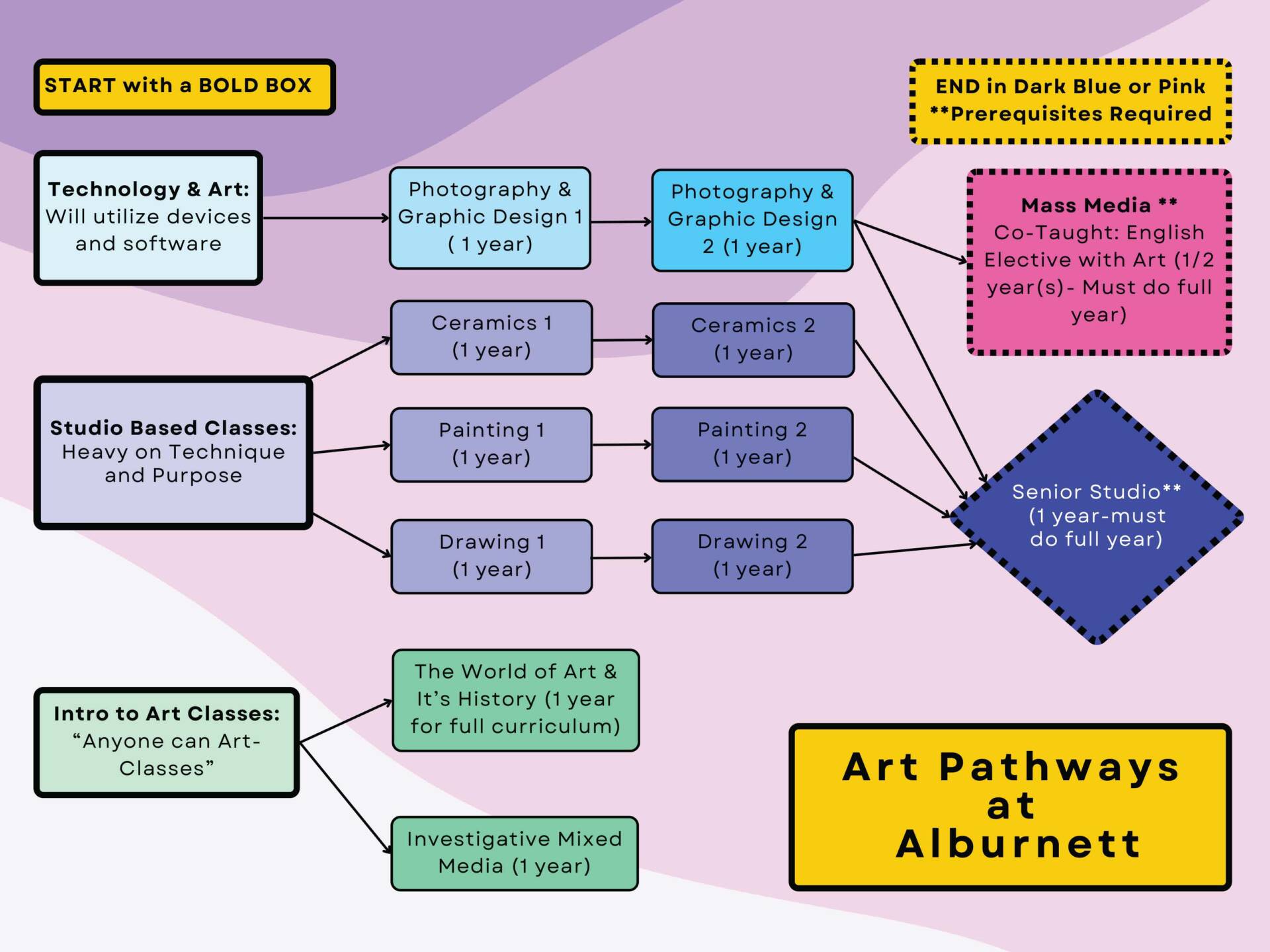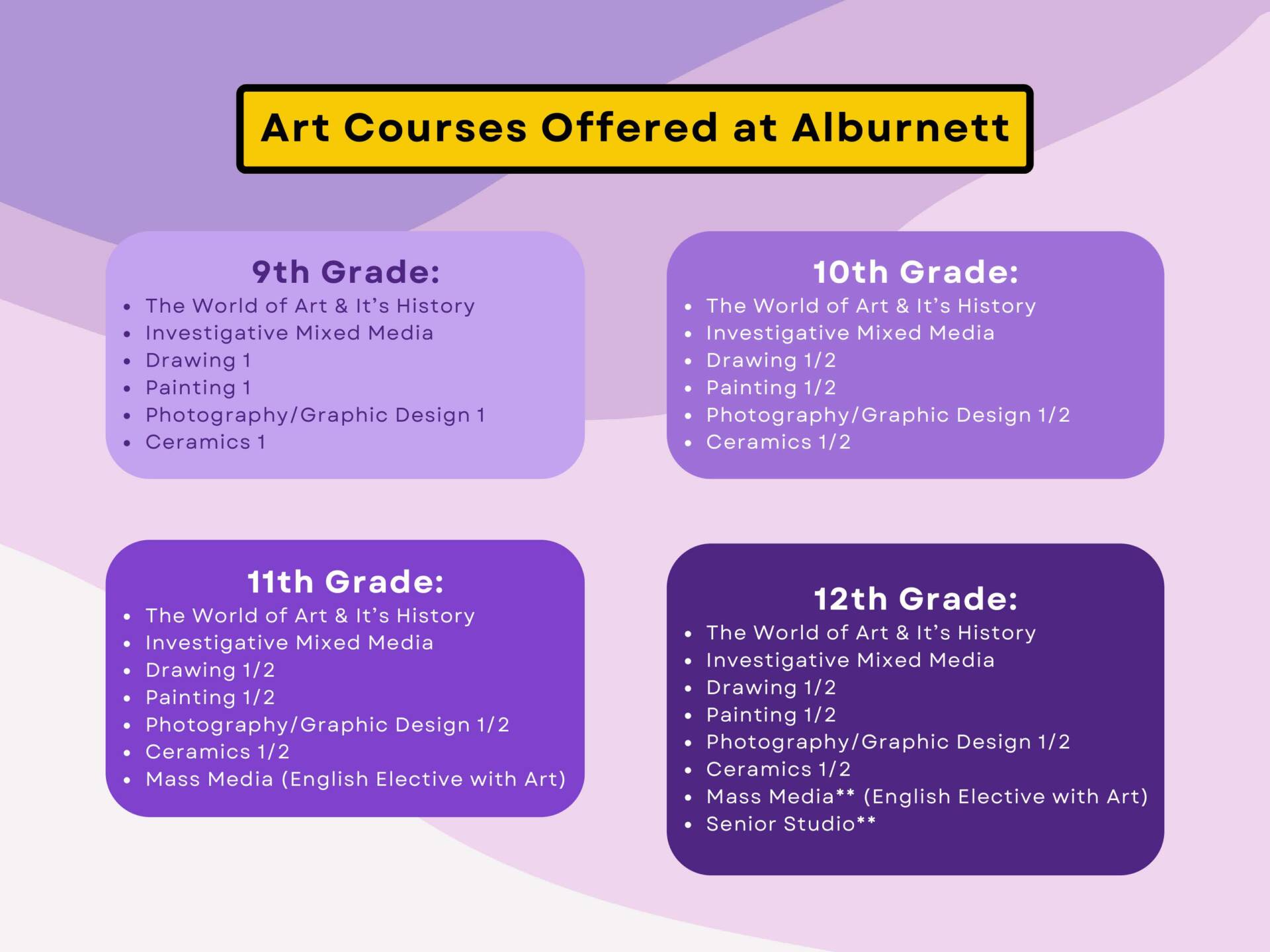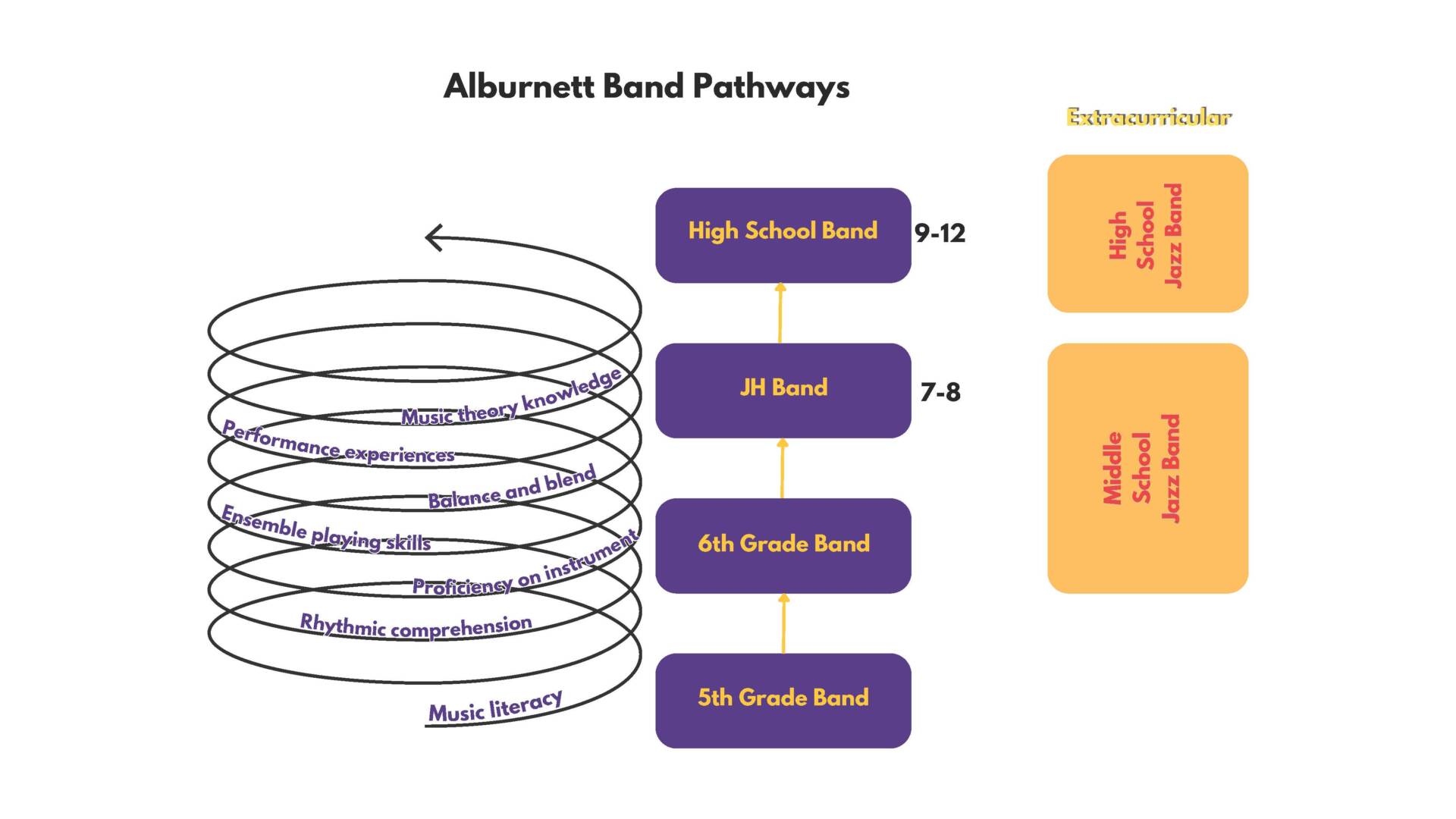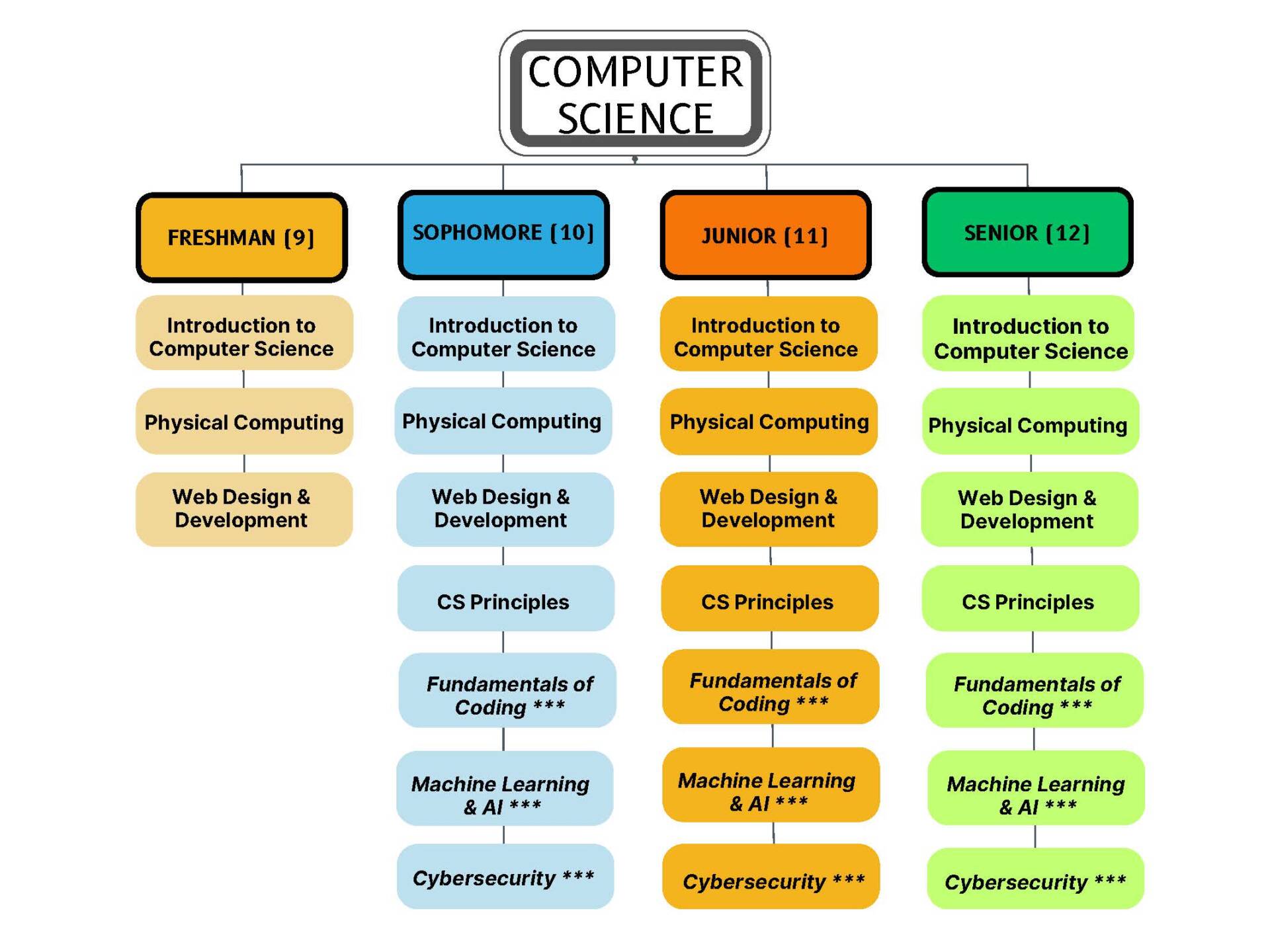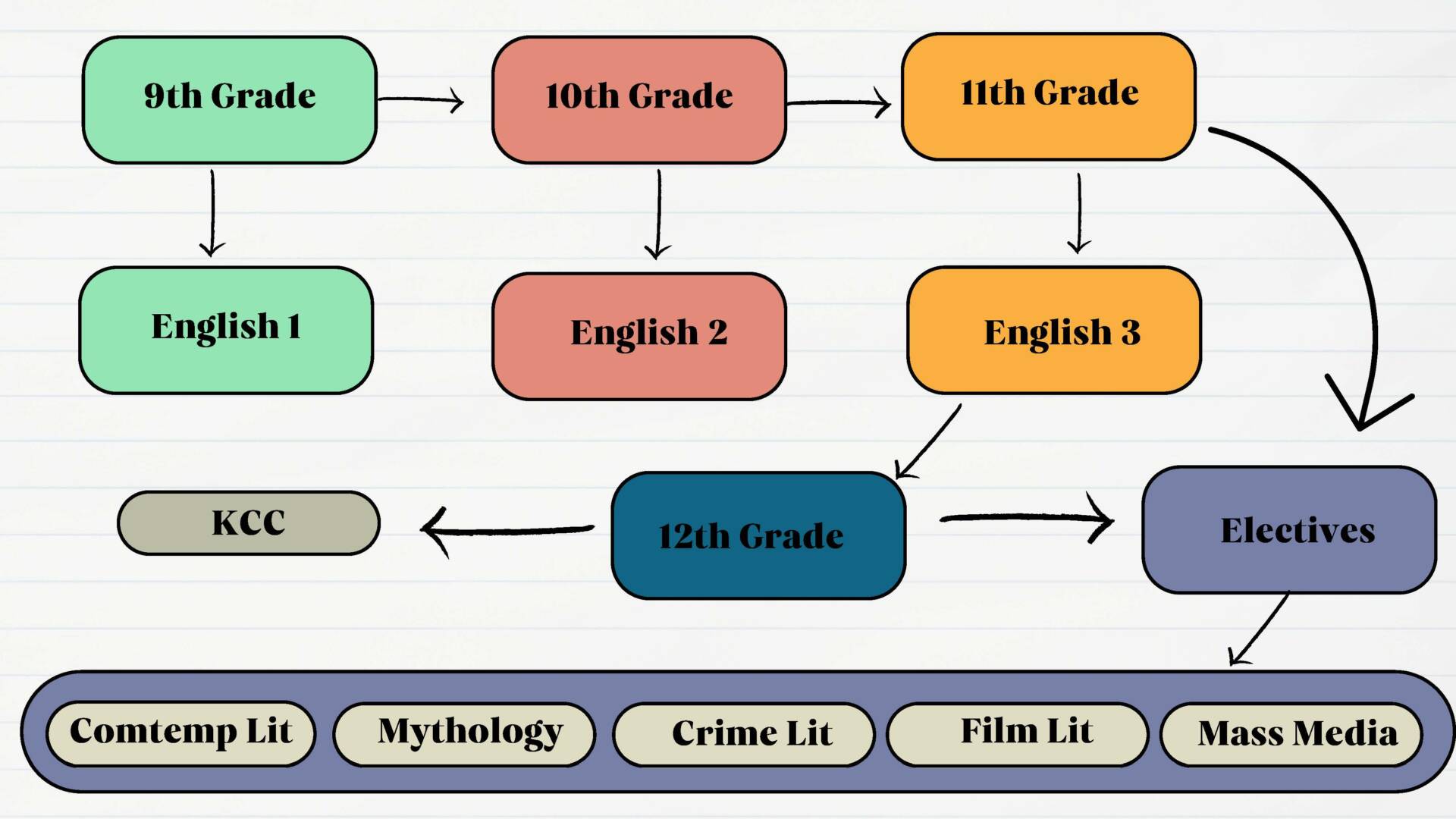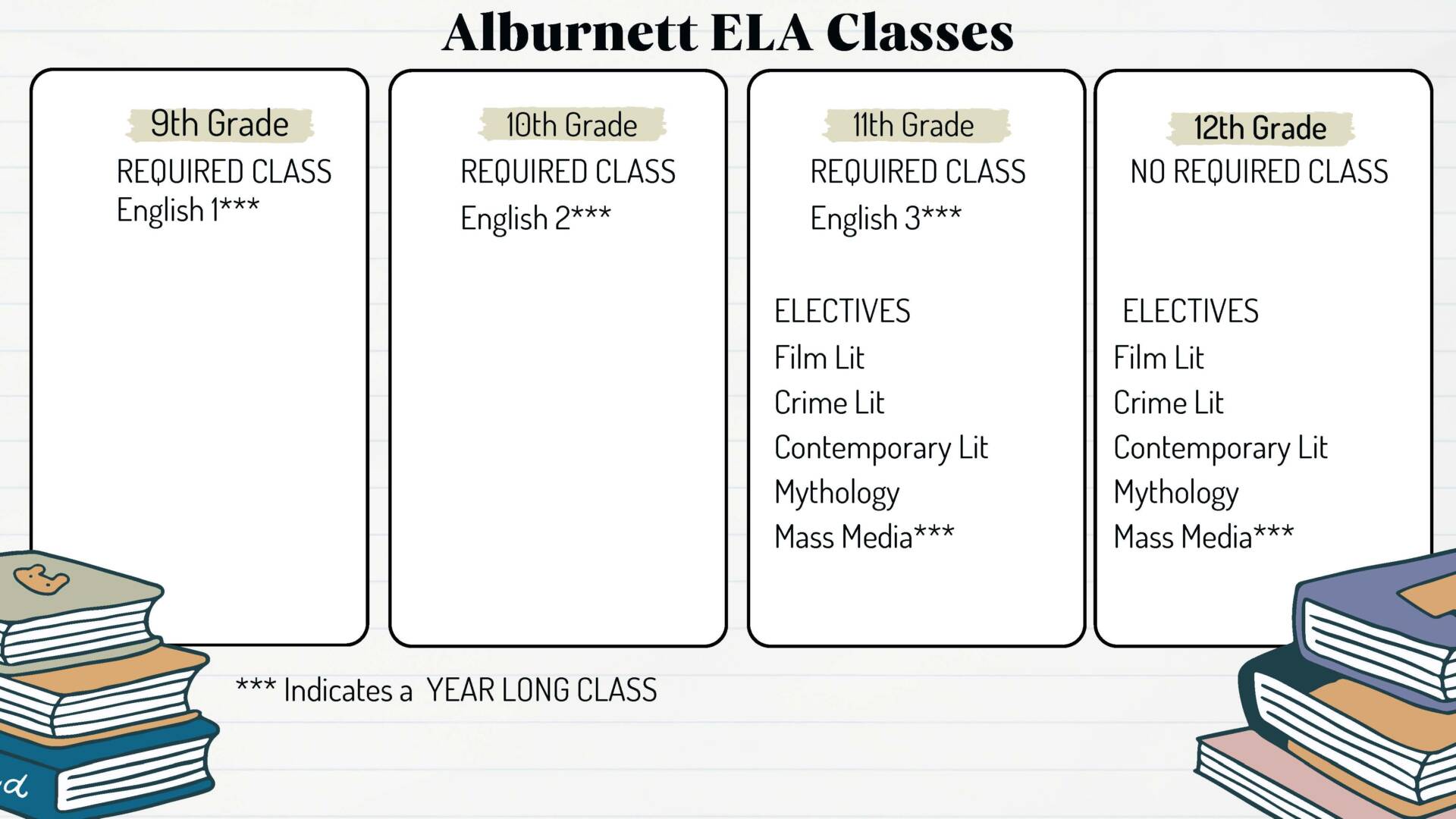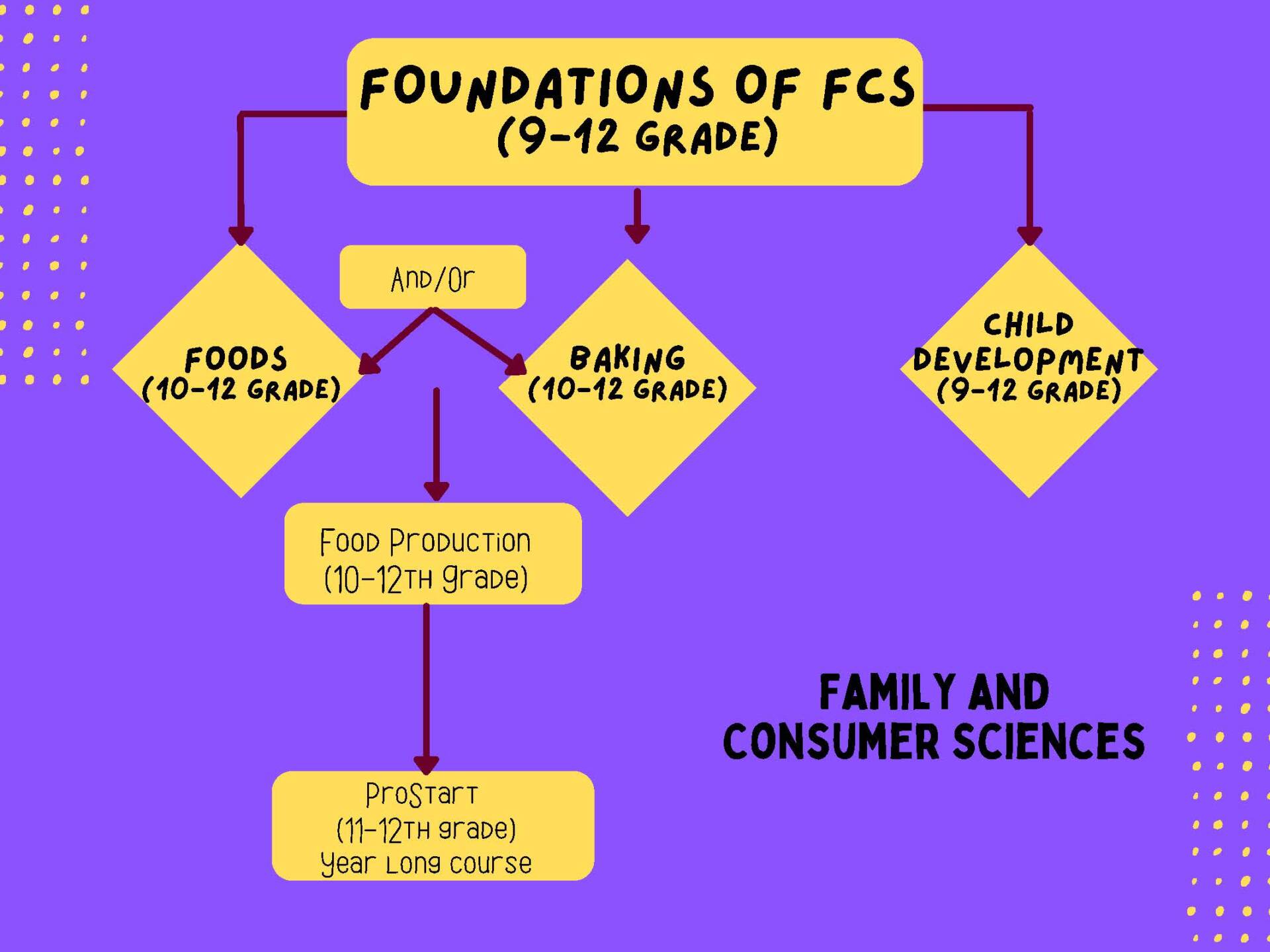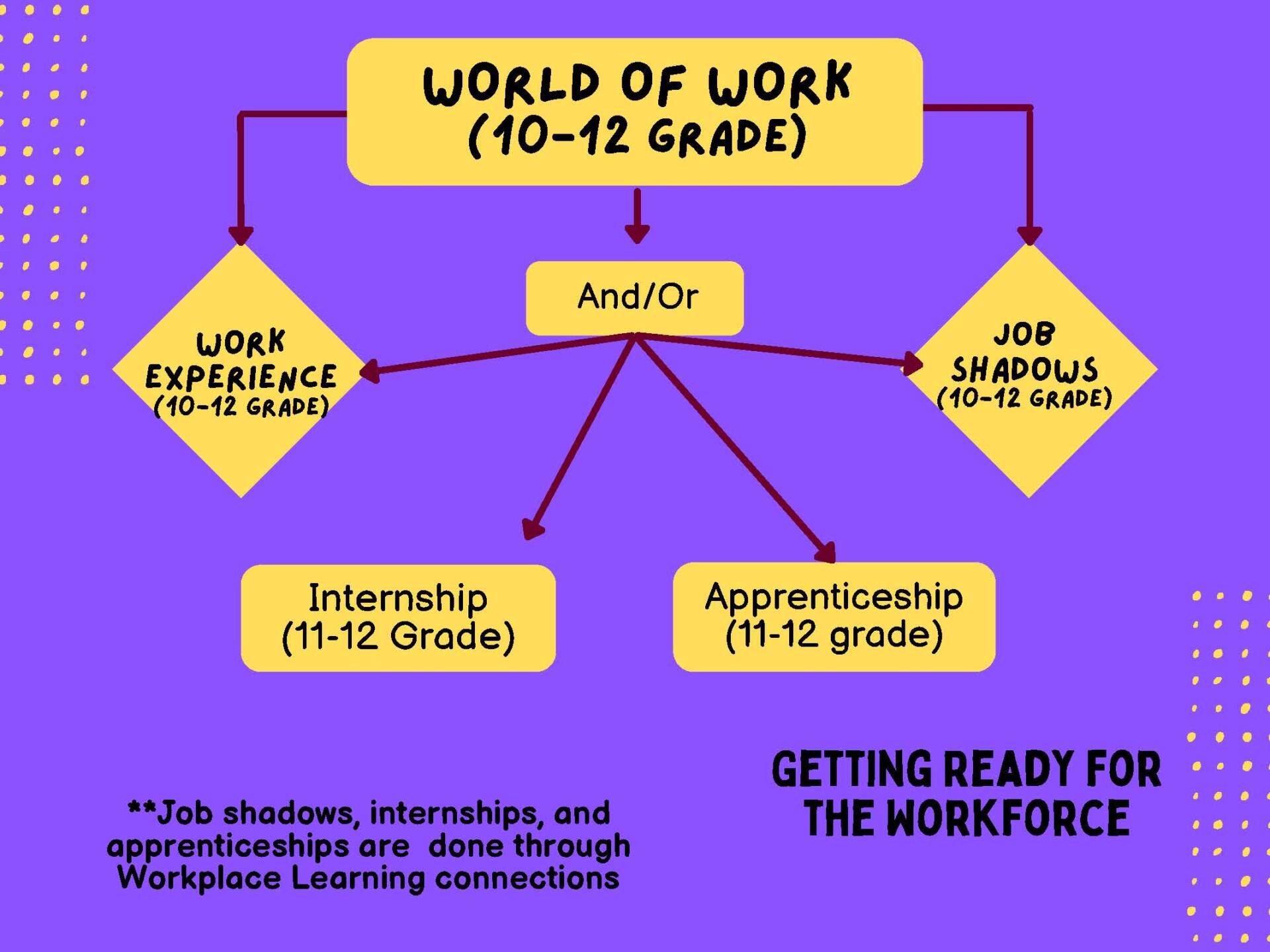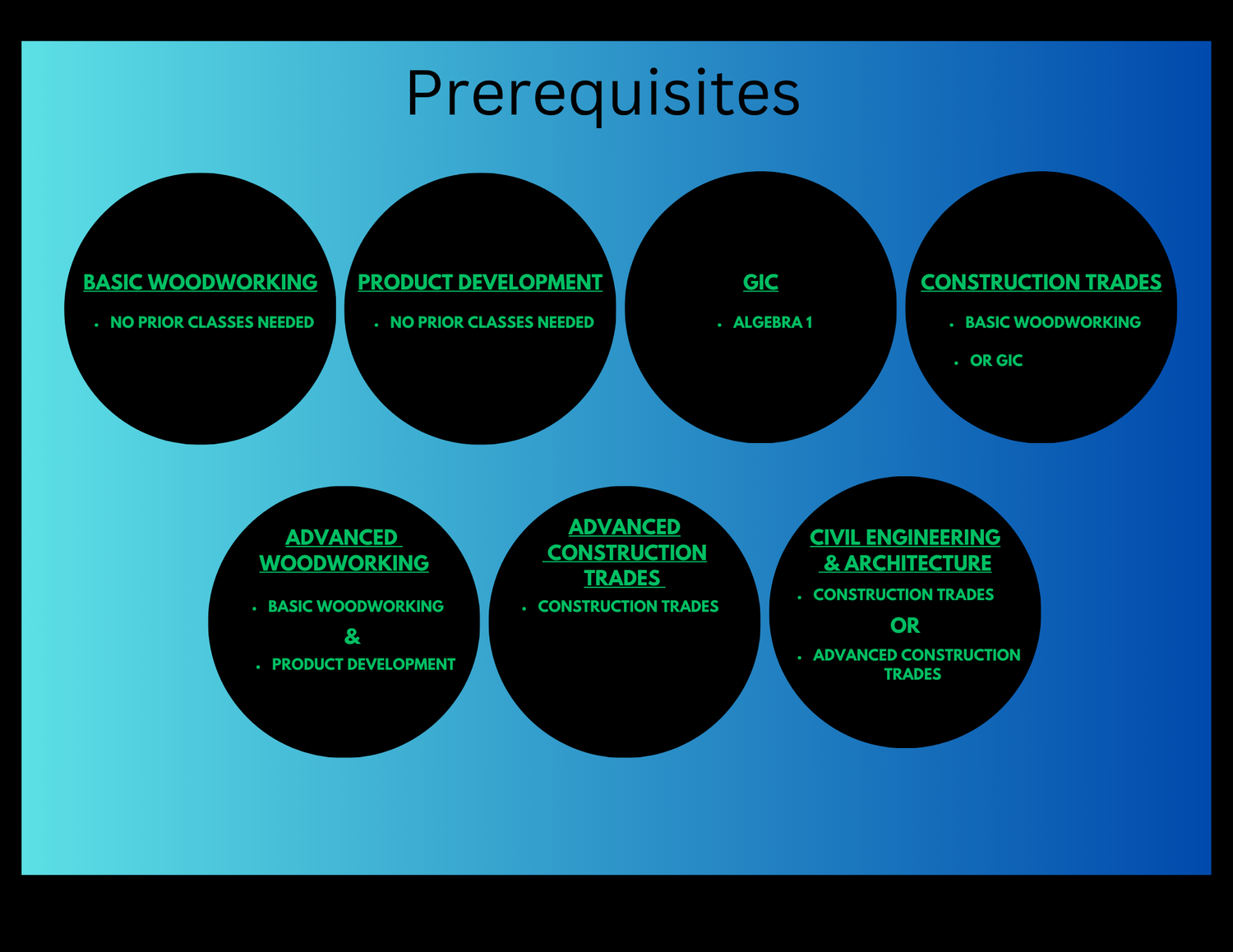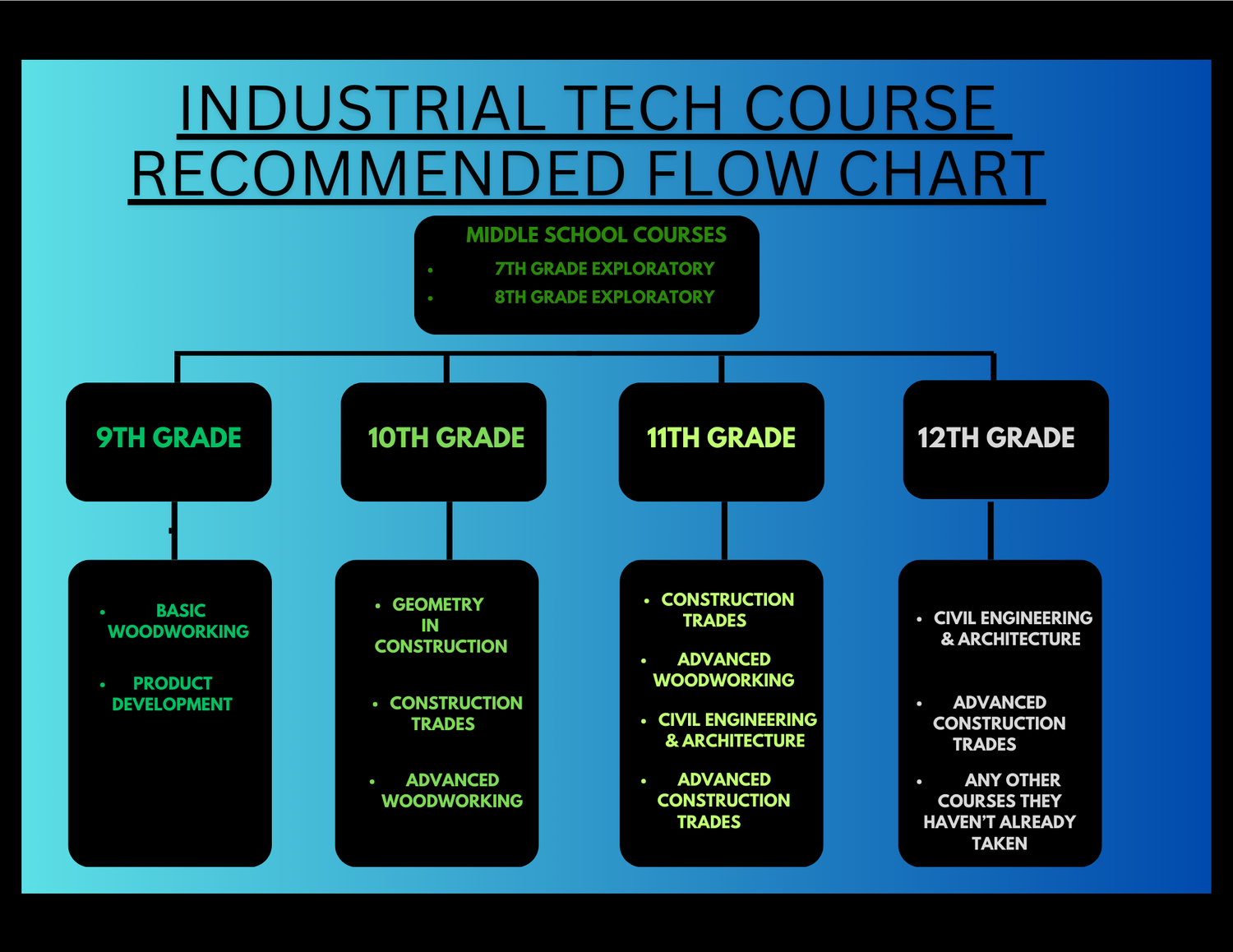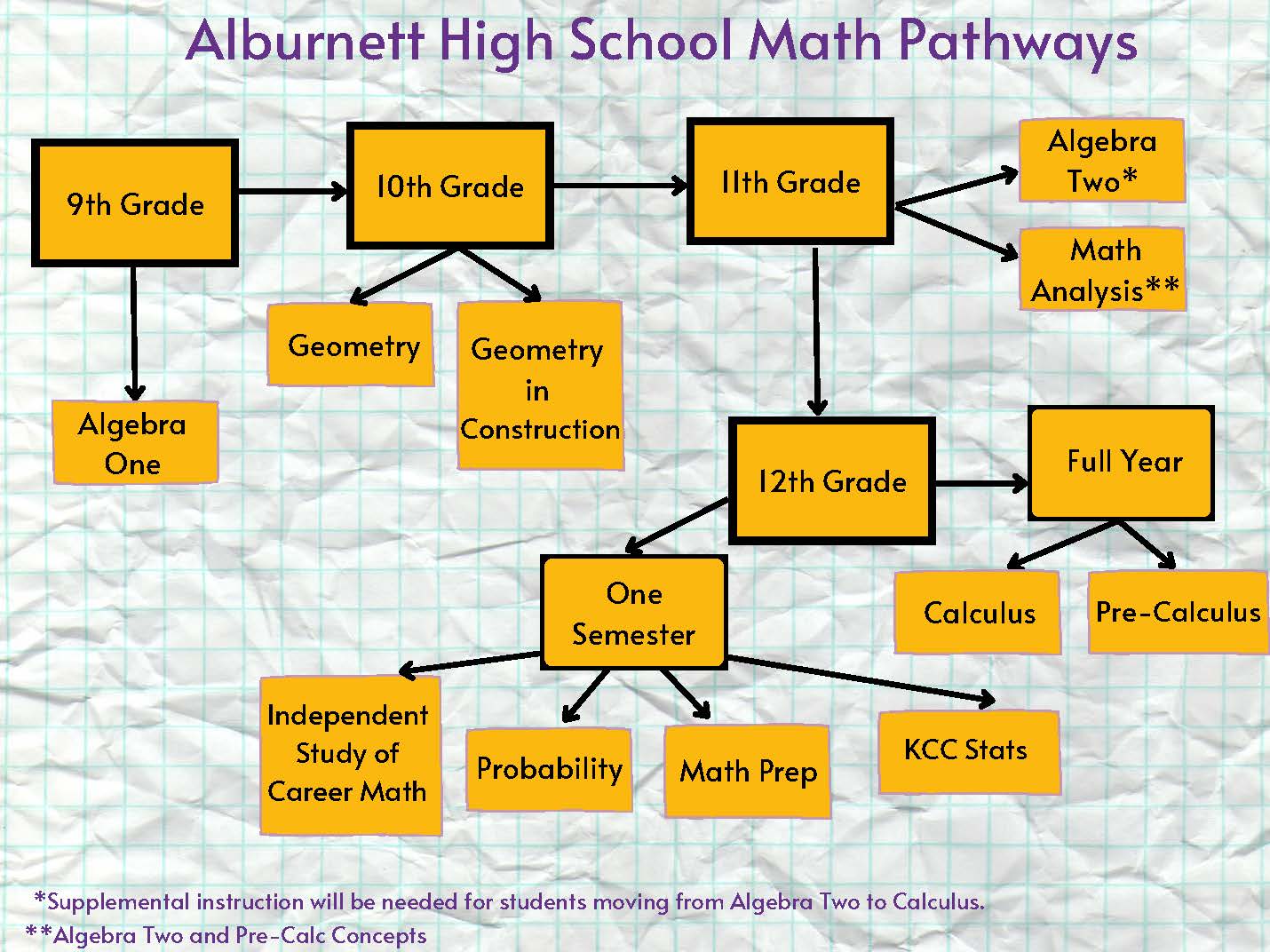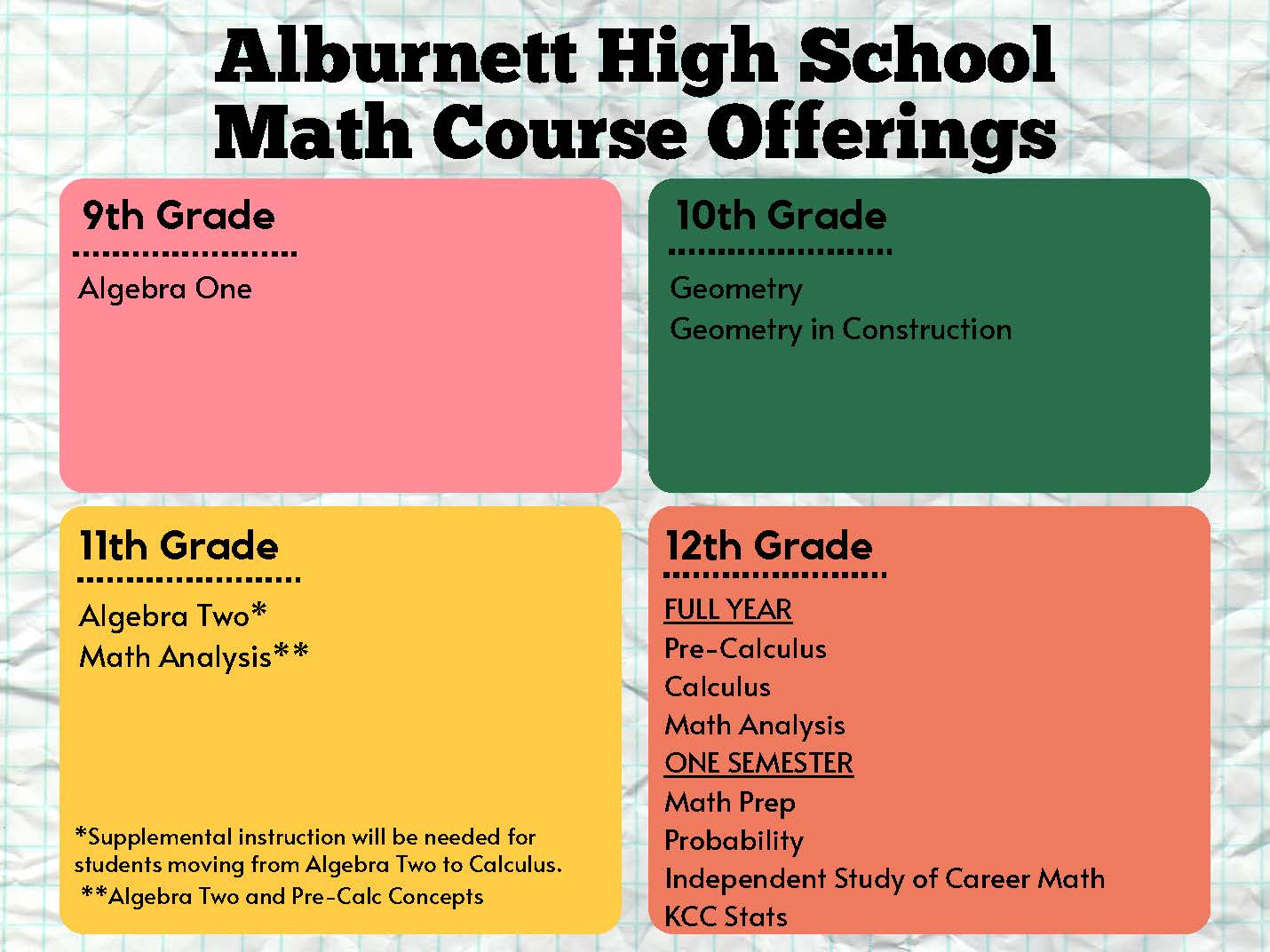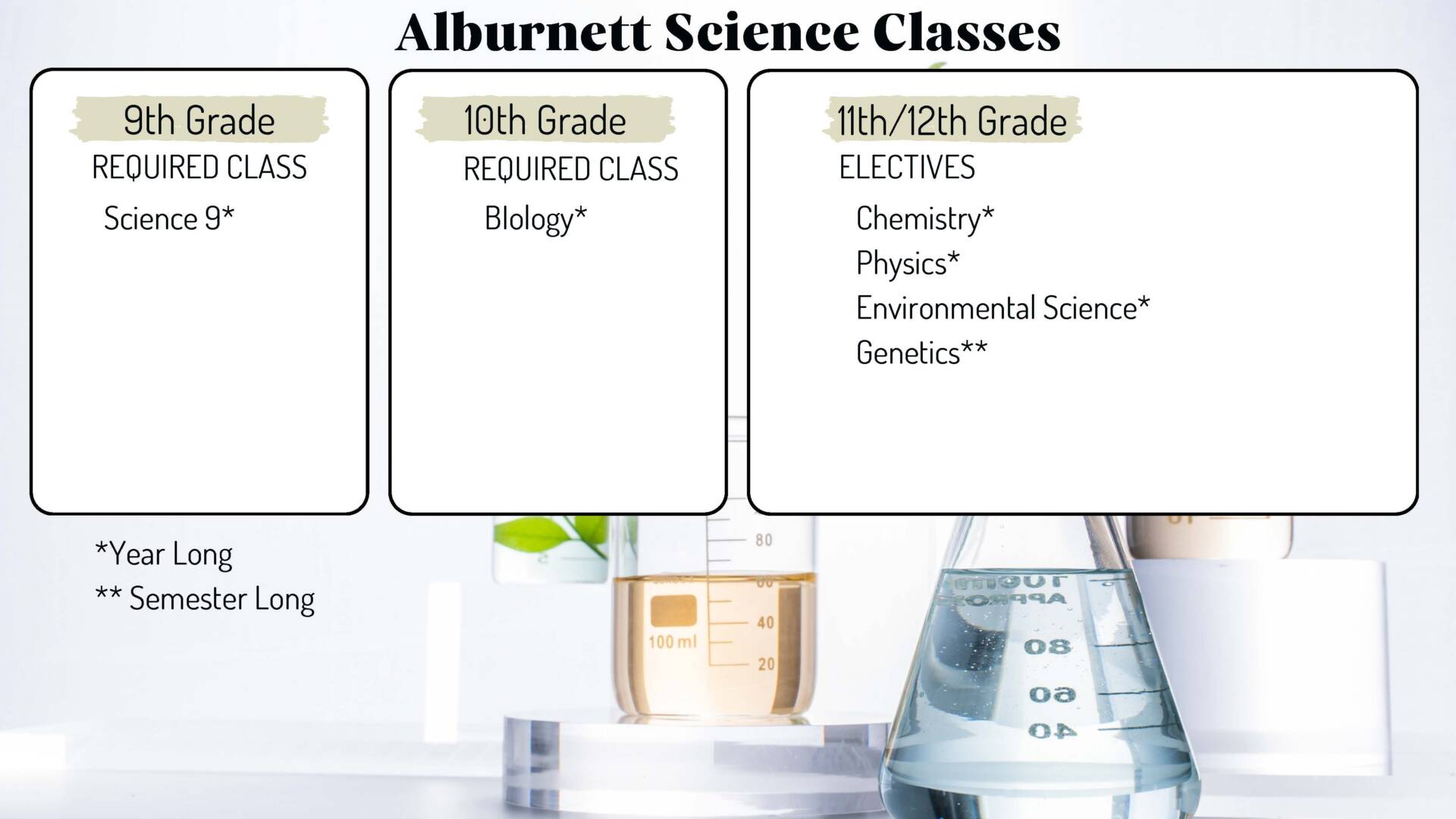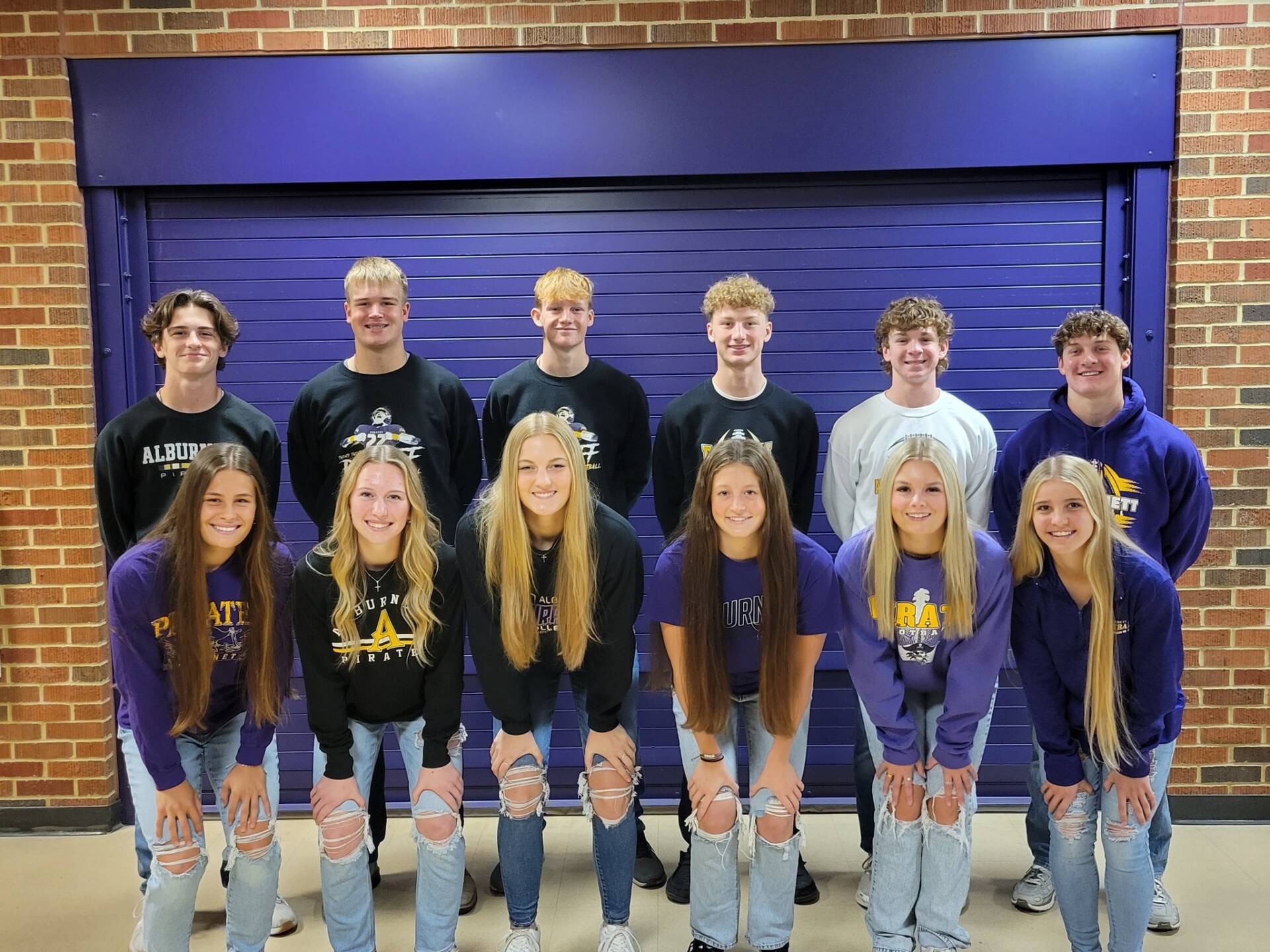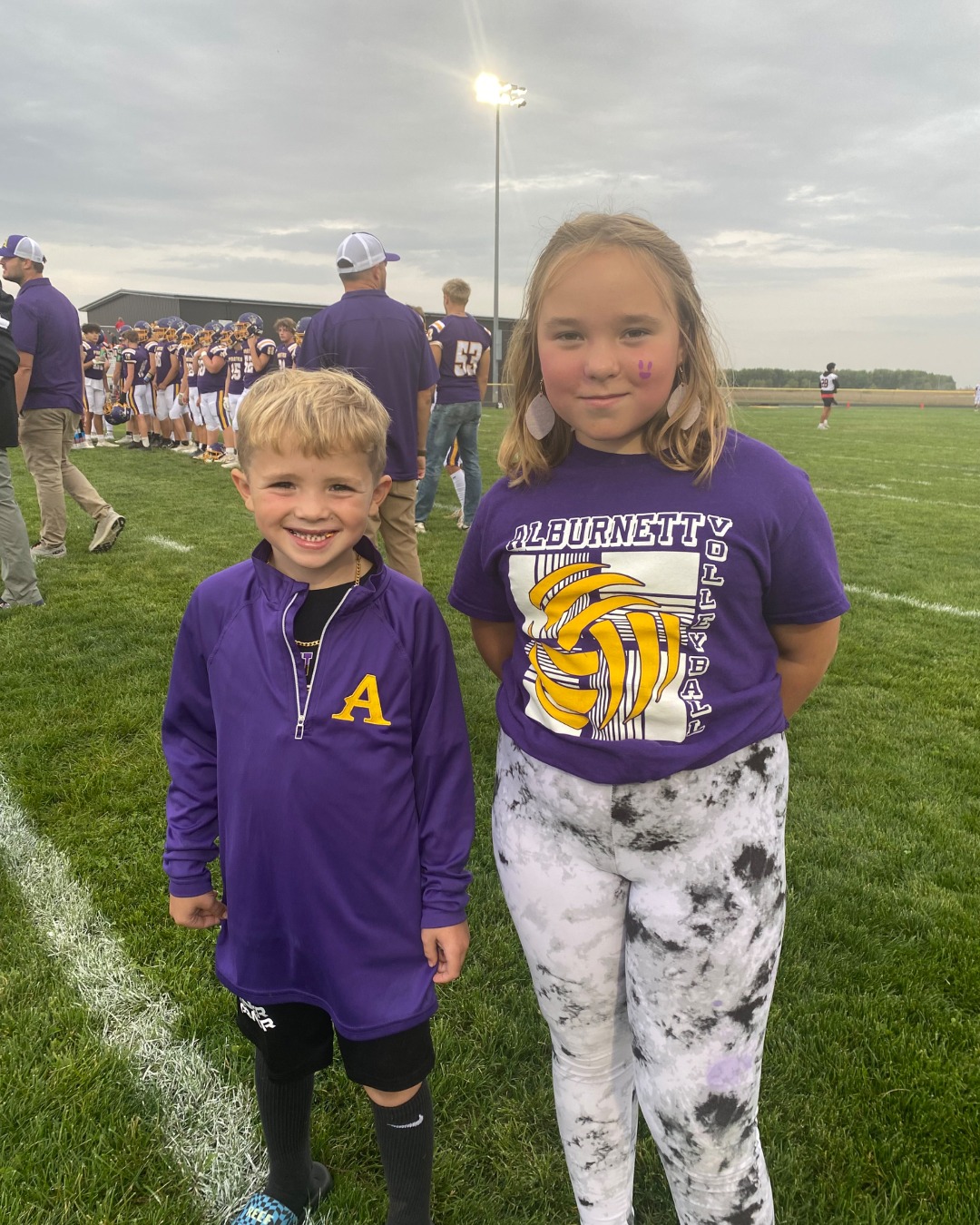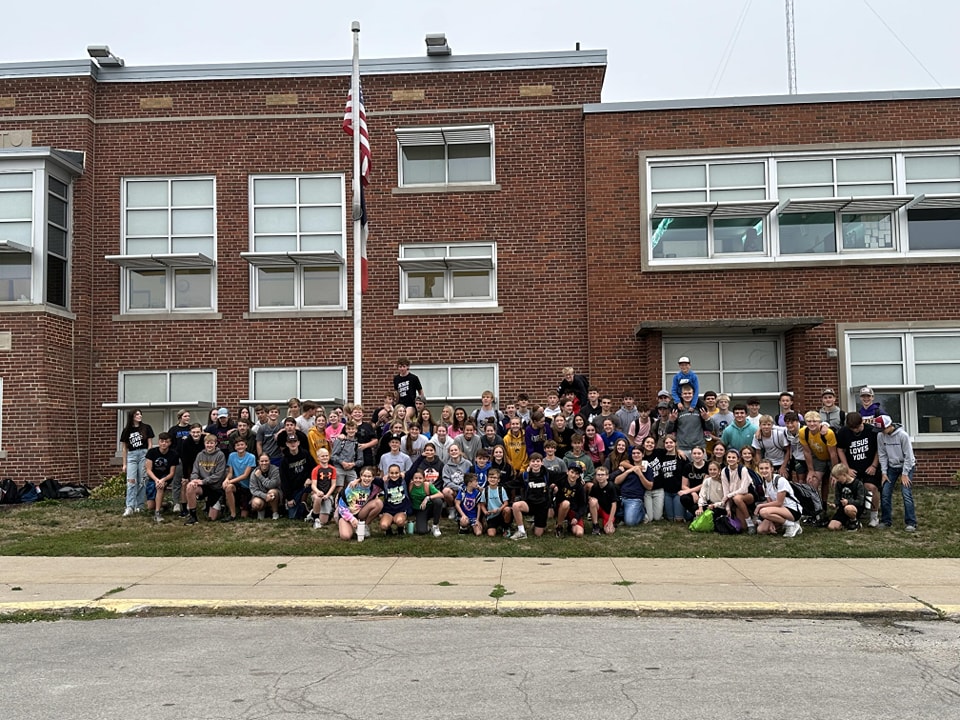Courses
Flow Charts & Priority Standards
Printable Versions (pdf) | Flow Chart | Priority Standards
Flow Chart
Priority Standards
Coming soon!
Printable Versions (pdf) | Flow Chart | Priority Standards
Flow Chart
Priority Standards
1st Semester
- Be able to play all twelve major scales on their instrument from memory
- MU:Pr5.3.E.5a
- MU:Pr4.2.E.5a
- Be able to play the chromatic scale across the practical range of their instrument from memory
- MU:Pr5.3.E.5a
- MU:Pr4.2.E.5a
- Perform on their instrument the “rhythm assessments” appointed for the semester with full accuracy
- MU:Pr5.3.E.5a
- MU:Pr4.2.E.5a
- Make positive contributions to rehearsal each day in preparation for performances
- MU:Pr5.3.E.5a
- Participate in public performances alongside the rest of the ensemble
- MU:Pr6.1.E.5a
2nd Semester
- Be able to play minor scales in all forms for specific keys
- MU:Pr5.3.E.5a
- MU:Pr4.2.E.5a
- Be able to play the chromatic scale across the practical range of their instrument from memory
- MU:Pr5.3.E.5a
- MU:Pr4.2.E.5a
- Perform on their instrument the “rhythm assessments” appointed for the semester with full accuracy
- MU:Pr5.3.E.5a
- MU:Pr4.2.E.5a
- Make positive contributions to rehearsal each day in preparation for performances
- MU:Pr5.3.E.5a
- Participate in public performances alongside the rest of the ensemble
- MU:Pr6.1.E.5a
Printable Versions (pdf) | Flow Chart | Priority Standards
Flow Chart
Priority Standards
1st Semester
- Students will sing a major scale independently.
- Students will sing a natural minor scale independently.
- Students will correctly identify and label notes on the treble clef staff.
- Students will correctly identify and label notes on the bass clef staff.
- Students will read rhythm patterns with simple beat division in duple, triple, or quadruple meter.
- Students will read rhythm patterns with extension dots (simple beat subdivision in duple, triple, or quadruple meter).
- Students will read rhythm patterns with ties in simple beat division in duple, triple, or quadruple meter.
- Students will improve the quality of their performance in gradual practice of concert repertoire in lessons and in class rehearsals.
- Students will attend and participate in concert performances.
- Students will perform with age-appropriate performance factors based on the state adjudication criteria (tone quality, intonation, rhythm, balance/blend, technique, interpretation/musicianship, diction, and other performance factors).
- Students will reflect on their concert performance based on the state adjudication criteria (tone quality, intonation, rhythm, balance/blend, technique, interpretation/musicianship, diction, and other performance factors).
2nd Semester
- Students will correctly and independently identify and label notes on the treble clef staff and two ledger lines above or below the staff.
- Students will correctly and independently identify and label notes on the bass clef staff and two ledger lines above or below the staff.
- Students will sing a major tonic triad independently.
- Students will sing a minor tonic triad independently.
- Students will read rhythms featuring one or more of the following characteristics: paired eighth notes, quarter rests, eighth rests for syncopation of quarter and/or eighth notes.
- Students will improve the quality of their performance in gradual practice of concert repertoire in lessons and in class rehearsals.
- Students will attend and participate in concert performances.
- Students will perform with age-appropriate performance factors based on the state adjudication criteria (tone quality, intonation, rhythm, balance/blend, technique, interpretation/musicianship, diction, and other performance factors).
- Students will reflect on their concert performance based on the state adjudication criteria (tone quality, intonation, rhythm, balance/blend, technique, interpretation/musicianship, diction, and other performance factors).
1st Semester
- Students will correctly and independently identify and label notes on the treble clef staff two ledger lines above or below the staff.
- Students will correctly and independently identify and label notes on the bass clef staff two ledger lines above or below the staff.
- Students will sing a major tonic triad independently.
- Students will sing a minor tonic triad independently.
- Students will read and sing a melody that moves by step in a major key.
- Students will read and sing a melody that moves by step in a minor key.
- Students will read rhythm patterns with simple beat subdivision in duple, triple, or quadruple meter (quarter note = beat).
- Students will read rhythm patterns with simple beat subdivision in duple, triple, or quadruple meter (half note = beat).
- Students read rhythm patterns with compound beat division in duple, triple, or quadruple meter.
- Students will improve the quality of their performance in gradual practice of concert repertoire in lessons and in class rehearsals.
- Students will perform with age-appropriate performance factors based on the state adjudication criteria (tone quality, intonation, rhythm, balance/blend, technique, interpretation/musicianship, diction, and other performance factors).
- Students will reflect on their concert performance based on the state adjudication criteria (tone quality, intonation, rhythm, balance/blend, technique, interpretation/musicianship, diction, and other performance factors).
2nd Semester
- Students will sing a dominant triad independently (minor mode).
- Students will correctly and independently identify and label notes on the bass clef staff and two ledger lines above or below the staff.
- Students will sing the harmonic minor scale.
- Students will identify and write in "Do" using key signatures with or without flats and sharps.
- Students will identify and write in "La" using key signatures with or without flats and sharps.
- Students will sing a dominant triad independently (major mode).
- Students will read and sing a melody with 2nds, 3rds, 4ths, and 5ths in a major key.
- Students will read rhythms featuring one or more of the following characteristics: sixteenth notes combined with eighths, and basic compound patterns.
- Students will reflect on their concert performance based on the state adjudication criteria (tone quality, intonation, rhythm, balance/blend, technique, interpretation/musicianship, diction, and other performance factors).
- Students will improve the quality of their performance in gradual practice of concert repertoire in lessons and in class rehearsals.
- Students will perform with age-appropriate performance factors based on the state adjudication criteria (tone quality, intonation, rhythm, balance/blend, technique, interpretation/musicianship, diction, and other performance factors).
- Students will reflect on their concert performance based on the state adjudication criteria (tone quality, intonation, rhythm, balance/blend, technique, interpretation/musicianship, diction, and other performance factors).
1st Semester
- Students will sing the harmonic minor scale.
- Students will identify and write in "Do" using key signatures with or without flats and sharps.
- Students will identify and write in "La" using key signatures with or without flats and sharps.
- Students will sing a dominant triad independently (major mode).
- Students will sing a dominant triad independently (minor mode).
- Students will read and sing a melody with 2nds, 3rds, 4ths, and / or 5ths in a major key.
- Students will read and sing a melody with 2nds, 3rds, 4ths, and / or 5ths in a minor key.
- Students will read rhythm patterns with dotted eighth note-sixteenth note patterns in simple beat subdivision in duple, triple, or quadruple meter.
- Students will read rhythm patterns with triplets and simple beat division rests in simple beat division in duple, triple, or quadruple meter.
- Students will read rhythm patterns with compound beat subdivision in duple, triple, and quadruple meter.
- Students will improve the quality of their performance in gradual practice of concert repertoire in lessons and in class rehearsals.
- Students will perform with age-appropriate performance factors based on the state adjudication criteria (tone quality, intonation, rhythm, balance/blend, technique, interpretation/musicianship, diction, and other performance factors).
- Students will reflect on their concert performance based on the state adjudication criteria (tone quality, intonation, rhythm, balance/blend, technique, interpretation/musicianship, diction, and other performance factors).
2nd Semester
- Sing the melodic minor scale.
- Correctly identify and name 7 major key signatures. (E-flat, B-flat, F, C, G, D, and A Major)
- Correctly identify and name 7 minor key signatures. (c, g, d, a, e, b, and f-sharp)
- Sing the major tonic triad in root position, 1st inversion, and 2nd inversion.
- Sing the minor tonic triad in root position, 1st inversion, and 2nd inversion.
- Read and sing a melody with intervals up to a 6th in a major key.
- Read and sing a melody with intervals up to a 6th in a minor key.
- Rhythm assessment featuring one or more of the following characteristics: compound rhythms that involve sixteenth notes.
- Students will improve the quality of their performance in gradual practice of concert repertoire in lessons and in class rehearsals.
- Students will perform with age-appropriate performance factors based on the state adjudication criteria (tone quality, intonation, rhythm, balance/blend, technique, interpretation/musicianship, diction, and other performance factors).
- Students will reflect on their concert performance based on the state adjudication criteria (tone quality, intonation, rhythm, balance/blend, technique, interpretation/musicianship, diction, and other performance factors).
1st Semester
- Students will sing the melodic minor scale.
- Students will sing the chromatic scale.
- Students will correctly identify and name 7 major key signatures. (E-flat, B-flat, F, C, G, D, and A Major)
- Students will correctly identify and name 7 minor key signatures. (c, g, d, a, e, b, and f-sharp)
- Students will visually identify and label interval quantities from a 2nd to an octave.
- Students will sing the major tonic triad in root position, 1st inversion, and 2nd inversion.
- Students will sing the minor tonic triad in root position, 1st inversion, and 2nd inversion.
- Students will sing the dominant triad in root position, 1st inversion, and 2nd inversion (major mode).
- Students will sing the dominant triad in root position, 1st inversion, and 2nd inversion (minor mode).
- Students will sing a subdominant triad independently (major mode).
- Students will sing a subdominant triad independently (minor mode).
- Students will read and sing a melody with intervals up to a 6th in a major key.
- Students will read and sing a melody with intervals up to a 6th in a minor key.
- Students will read rhythm patterns with simple beat division rests in duple, triple, or quadruple meter.
- Students will read rhythm patterns with compound beat division in duple, triple, or quadruple meter.
- Students will read rhythm patterns with sextuplets in duple, triple, or quadruple meter.
- Students will read rhythm patterns with simple beat division syncopation in duple, triple, or quadruple meter.
- Students will improve the quality of their performance in gradual practice of concert repertoire in lessons and in class rehearsals.
- Students will perform with age-appropriate performance factors based on the state adjudication criteria (tone quality, intonation, rhythm, balance/blend, technique, interpretation/musicianship, diction, and other performance factors).
- Students will reflect on their concert performance based on the state adjudication criteria (tone quality, intonation, rhythm, balance/blend, technique, interpretation/musicianship, diction, and other performance factors).
2nd Semester
- Students will sing the pentatonic scale.
- Students will correctly identify and name all major key signatures.
- Students will correctly identify and name all minor key signatures.
- Students will visually identify and label interval quantities and qualities from a 2nd to an octave.
- Students will sing the subdominant triad in root position, 1st inversion, and 2nd inversion (major mode).
- Students will sing the subdominant triad in root position, 1st inversion, and 2nd inversion (minor mode).
- Students will read and sing a melody with intervals up to an octave in a major key.
- Students will read and sing a melody with intervals up to an octave in a minor key.
- Students will improve the quality of their performance in gradual practice of concert repertoire in lessons and in class rehearsals.
- Students will perform with age-appropriate performance factors based on the state adjudication criteria (tone quality, intonation, rhythm, balance/blend, technique, interpretation/musicianship, diction, and other performance factors).
- Students will reflect on their concert performance based on the state adjudication criteria (tone quality, intonation, rhythm, balance/blend, technique, interpretation/musicianship, diction, and other performance factors).
1st Semester
- Sing the whole-tone scale.
- Visually identify and label interval quantities and qualities from a 2nd to an octave.
- Sing the tonic, subdominant, dominant, tonic triad chord progression (major mode; I-IV-V-I).
- Sing the tonic, subdominant, dominant, tonic triad chord progression (minor mode; i-iv-V-i).
- Read and sing a stepwise melody with accidentals in a major key.
- Read and sing a stepwise melody with accidentals in a minor key.
- Students will improve the quality of their performance in gradual practice of concert repertoire in lessons and in class rehearsals.
- Students will perform with age-appropriate performance factors based on the state adjudication criteria (tone quality, intonation, rhythm, balance/blend, technique, interpretation/musicianship, diction, and other performance factors).
- Students will reflect on their concert performance based on the state adjudication criteria (tone quality, intonation, rhythm, balance/blend, technique, interpretation/musicianship, diction, and other performance factors).
2nd Semester
- Aurally identify and label interval quantities and qualities from a 2nd to an octave.
- Sing the dominant-seventh chord (major mode).
- Sing the dominant-seventh chord (minor mode).
- Read and sing a melody with 2nds, 3rds, 4ths, and / or 5ths and accidentals in a major key.
- Read and sing a melody with 2nds, 3rds, 4ths, and / or 5ths and accidentals in a minor key.
- Students will improve the quality of their performance in gradual practice of concert repertoire in lessons and in class rehearsals.
- Students will perform with age-appropriate performance factors based on the state adjudication criteria (tone quality, intonation, rhythm, balance/blend, technique, interpretation/musicianship, diction, and other performance factors).
- Students will reflect on their concert performance based on the state adjudication criteria (tone quality, intonation, rhythm, balance/blend, technique, interpretation/musicianship, diction, and other performance factors).
Printable Versions (pdf) | Flow Chart | Priority Standards
Flow Chart
Priority Standards
1 Semester
Students learn programming, web design, and internet safety. They code with Tracy the Turtle, create websites, and explore internet innovations. The Tech Apps and Coding course emphasizes creativity, problem-solving, and project-based learning to spark interest in computer science.
1 Semester
Students in the Physical Computing unit use App Lab and Adafruit’s Circuit Playground, Arduino products, and micro:bits to develop programs that mimic smart devices, progressing from prototypes to finished products. They learn to create responsive prototypes using everyday materials, fostering a "maker" mindset.
1 Semester
Students will learn to build web pages using HTML and CSS in a project-based course. They will create live homepages as portfolios without needing prior coding experience.
2 Semesters
***Prerequisite: Intro to CS
This course introduces high school students to modern computing principles over two semesters. Topics include programming in Javascript, algorithms, big data, digital privacy, security, and societal impacts. Students learn digital representation using binary code and develop UI/UX design skills for app development.
1 Semester
***Prerequisite: Intro to CS
Here, you'll dive into coding using Scratch and Python. You'll learn basic concepts like how to use variables, loops, and if-else statements. From making cool animations and games in Scratch to creating your programs in Python, you'll build problem-solving skills and learn how to think like a computer whiz.
1 Semester
***Prerequisite: Intro to CS
Craft your own AI solutions in a course focusing on machine learning and AI, exploring how technology like ChatGPT, Alexa, Tesla's self-driving, and Netflix's recommendations can drive positive change through data-driven insights. Develop AI innovations responsibly to make a difference ethically.
1 Semester
***Prerequisite: Intro to CS
The course is for students interested in Cybersecurity careers. It covers network and computer security, threat identification, cryptography, and hands-on labs for system vulnerability mitigation. Each unit includes cyber ethics and law, with an ethics agreement required to be signed by students and parents within the first 2 weeks.
Printable Versions (pdf) | Flow Chart | Priority Standards
Flow Chart
Priority Standards
1st Semester
- RL.9-10.1 - Textual Evidence
- RL.9-10.2 - Theme
- W.9-10.3 - Narrative Writing
- W.9-10.4 - Coherent Writing
- SL.9-10.1 - Collaborative Discussion
- SL.9-10.5 - Digital Media
- SL.9-10.6 - Interviews
Students will:
-
- Analyze Romeo & Juliet
- Participate in group projects
- Present information as a group
- Develop visual aids using digital media
- Create a resume
- Participate in a mock interview
- Develop writing as a whole
2nd Semester
- RL.9-10.1 - Textual Evidence
- RL.9-10.4 - POV
- RL.9-10.7 - Analyze a Subject
- W.9-10.2 - Informative Writing
- W.9-10.7 - Research
- W.9-10.10 - Timed Writing
- SL.9-10.4 - Presentation
- SL.9-10.5 - Digital Media
Students will:
-
- Read & analyze The Princess
Bride - Develop writing in a time limit
- Present their research to a group
- Develop visual aids using digital media
- Greek Mythology
- Informative writing
- Read & analyze The Princess
1st Semester
- RL 9-10.5 Plot Structure
- W 9-10.3 Narrative Writing
- RI 9-10.1 Citing Evidence
- W 9-10.7 Conduct Research
- SL 9-10.5 Digital Media Presentation
- W 9-10.2 Informational Writing
Students will:
-
- Read fictional short stories and analyze the structure
- Write short stories
- Utilize sensory and description language
- Understand plagiarism and the ways to avoid it
- Learn the CRAAP test and apply it to research
- Research skills
- Learn about and create claims
- Utilize digital media to create projects and presentations
- Good speaking characteristics
2nd Semester
- W 9-10.10 Timed Writing
- RI 9-10.2 Central Idea
- SL 9-10.4 Present Information
- W 9-10.1 Argument Writing
- RL 9-10.1 Citing Evidence
- RL 9-10.2 Identifying Theme
- RL 9-10.3 Analyzing Characters
Students will:
-
- Read information articles
- Identify and analyze the central idea and theme of written works
- Use ethos, pathos, and logos as methods of persuasion
- Write persuasive speech
- Cite evidence from research to support claims
- Read a class novel
- Analyze characters and their growth over the course of a novel
1st Semester
- W.11-12.10 Writing Diagnostics
- W.11-12.3 Narrative Writing
- SL.11-12.6 Speech Adaptation
- RI.11-12.7 Analyze Origins
- SL.11-12.4 Present Information
- RL.11-12.1 Citing Evidence
- SL. 11-12.2 Using Multiple Sources
Students will:
-
- Complete timed writing diagnostics
- Write personal narratives
- Use imagery and descriptive writing
- Memorable endings
- Concise speaking and focusing on a single topic
- Good speaking characteristics
- Research skills and finding credible resources
- Analyzing multiple folklore stories
- Present using a visual aid
- Understand media usage, bias, and filter bubbles
- Reflect on media usage and impact
2nd Semester
- W.11-12.1 - Persuasive Writing
- W.11-12.4 - Production of Writing
- W.11-12.5 - Development of Writing
- W.11-12.10 - Writing Diagnostics
- SL.11-12.5 - Digital Media
- Sl.11-12.6 - Speech Adaptation
Students will:
-
- Complete timed writing diagnostics
- Write persuasively about an influential individual
- Create a visual aid using digital media
- Demonstrate professional writing (Resume, Cover Letter)
- Present in front of peers
- Teach 15 minutes lesson to peers
1st & 2nd Semester
- SL.11-12.1 - Collaborative Discussion
- SL.11-12.4 - Present information
- SL.11-12.5 - Utilize Digital Media
- W.11-12.4 - Production of Writing
- W.11-12.6 - Writing with Technology
Students will:
-
- Develop and maintain a portfolio
- Collaborate with peers
- Participate in interviews
- Produce writing for yearbook, newsletter, social media, etc
- Utilize tech programs
1st Semester
- RI 11-12.6 Author/Directors POV
- EL 11-12.5 Author Choice: Structure
- RL 11-12.1 Citing Evidence
- SL 11-12.4 Present Information
- W 11-12.10 Timed Writing
- RL 11-12.6 Satire and Irony
Students will:
-
- Analyze different film genres
- Research directors and understand their role in the creation of movies
- Break down shorts, trailers, and full-length movies using literary analysis skills
- Understand and identify irony and satire
- Analyze how the film has adapted and changed
1st Semester
- W 11-12.9 Draw Evidence from Sources
- W 11-12.10 Timed Writing
- W 11-12.7 Research
- SL 11-12.2 Multiple Sources
- RL 11-12.5 Analyze Structure
- W 11-12.4 Coherent Writing
Students will:
-
- Research crimes on a local, regional, national, and international level
- Research and present about prison systems, cults, and cold cases
- Learn about different types of crimes
- Analyze detective stories
- Read crime literature and analyze the impact
1st Semester
- W.11-12.3 - Narrative Writing
- RL.11-12.1 - Citing Evidence
- RL.11-12.7 - Compare & Contrast
- W.11-12.7 - Research
- SL.11-12.5 - Digital Media
- W.11-12.8 - Assessment of Sources
Students will:
-
- Write narratively from the lens of different cultures
- Explore various cultures and mythologies
- Analyze pantheons and creatures
- Research and develop presentations of information
- Assess credibility of sources
1st Semester
- RL 11-12.1 Citing Evidence
- RL 11-12.10 On Level Reading
- RL 11-12.2 Themes
- RL 11-12.3 Authors Purpose
Students will:
-
- Read books at their current reading level
- Learn about different genres
- Present themes and messages from books
- Make connections between literature and the real world/self
- Create projects that reflect on the purpose behind the books
Printable Versions (pdf) | Flow Chart | Priority Standards
Flow Chart
Priority Standards
Coming soon!
Printable Versions (pdf) | Flow Chart | Priority Standards
Flow Chart
Priority Standards
Priority Standards
- Ind 3.1 Demonstrate safe practices and procedures with tools and equipment.
- CWP 3.1 Use portable power tools, such as single and compound miter saws, drills, sanders, saber saws and routers, safely and appropriately.
- IND 4.4 Exhibit a responsible work ethic.
- CWP 1.4 Know conventional measurement processes for cabinetmaking and wood products, linear measurements and conversions of fractions and decimals
Class Work/Projects
- Safety overview/safety exam
- Joinery unit- Students will learn different types of joinery that can be implemented into their work.
- Sofa Table project- Each student will make a sofa table. During this project, students will each make a sofa table where they will demonstrate: safety, joinery, finish work, 21st century skills, and ability to read blueprints.
- End Table
Students Will
- Demonstrate shop safety
- Understand Employability skills
- Know common fractions
- Understand the building process of a basic wood project
Priorities Standards
- Ind 3.1 Demonstrate safe practices and procedures with tools and equipment.
- CWP 3.1 Use portable power tools, such as single and compound miter saws, drills, sanders, saber saws and routers, safely and appropriately.
- IND 4.4 Exhibit a responsible work ethic.
- CWP 1.4 Know conventional measurement processes for cabinetmaking and wood products, linear measurements and conversions of fractions and decimals.
- CWP6.2 Develop a production plan, including the layout, bill of materials and cost analysis, for the production of cabinets or wood products.
- MNU10.2 Select appropriate tools, processes and equipment to successfully produce formed parts or products.
Class Work/Projects
- Safety overview/safety exam
- Students will work in groups and build production plans.
- Blueprints
- Material costs
- Price per unit
- Job assignments
- Sale price
- Once the production plans are completed, students will begin working in groups to complete their projects they have planned out.
- Students will work after school to sell their projects.
Students Will
- Demonstrate shop safety
- Understand Employability skills
- Know common fractions
- Understand the building process of a basic wood project
- Demonstrate the skills learned to form and operate a business/business plan
Priority Standards
- Ind 3.1 Demonstrate safe practices and procedures with tools and equipment.
- CWP 3.1 Use portable power tools, such as single and compound miter saws, drills, sanders, saber saws and routers, safely and appropriately.
- IND 4.4 Exhibit a responsible work ethic.
- CWP 1.4 Know conventional measurement processes for cabinetmaking and wood products, linear measurements and conversions of fractions and decimals.
- CWP6.2 Develop a production plan, including the layout, bill of materials and cost analysis, for the production of cabinets or wood products.
- MNU10.2 Select appropriate tools, processes and equipment to successfully produce formed parts or products.
Class Work/Projects
- Safety Test
- Safety Demonstration
- OSHA Training
- Balsa Wood Houses
- Designing and blueprinting to scale
- T-Shirt Designs/Printing
- Geometrical Shape Collage
- Stair stringer
- Customer project
- Shed
Students Will
- Demonstrate shop safety
- Understand Employability skills
- Know common fractions
- Understand the building process of a basic wood project
Priority Standards
- CON4.1 Interpret and use residential construction blueprints and specifications.
- CON4.4 Solve common residential construction problems, such as framing, plumbing and electrical, by using the official codes.
- CON6.4 Complete the phases of residential and commercial construction.
Class Work/Projects
- Learn about building codes
- Learn how to work through and recognize repairs.
- Work on different projects learning: construction techniques in framing, electrical, and plumbing
Students Will
- Demonstrate shop safety
- Understand Employability skills
- Know common fractions
- Understand building codes
- Demonstrate how to read a blueprint
- Understand basic trades concepts and a better understanding of opportunities in the trades
Priority Standards
- Ind 3.1 Demonstrate safe practices and procedures with tools and equipment.
- CWP 3.1 Use portable power tools, such as single and compound miter saws, drills, sanders, saber saws and routers, safely and appropriately.
- IND 4.4 Exhibit a responsible work ethic.
- CWP6.2 Develop a production plan, including the layout, bill of materials and cost analysis, for the production of cabinets or wood products.
- MNU10.2 Select appropriate tools, processes and equipment to successfully produce formed parts or products.
- CWP 6.1 Design and create cabinet and wood products.
Class Work/Projects
- Safety
- Blueprint reading
- Cabinetry
- CNC Programming
- Fusion360 (Autodesk)
Students Will
- Work on advanced woods projects such as cabinetry or various other large projects.
- Students can expect to learn about and use the CNC Router to make more intricate products.
Priority Standards
- DFT3.1 Know how the various measurement systems are used in engineering drawings
- CON 4.1 Interpret and use residential construction blueprints and specifications.
- CON4.2 Understand how to estimate materials from blueprints and specifications
Class Work/Projects
- Students will learn how to use Autodesk Revit
- Design a garden shed
- Students will design a home for a customer and follow strict guidelines set by Habitat for Humanity
- Students will design commercial buildings to develop a site plan for a “local community.”
- History of architecture
- Architectural Styles
- Building codes
Students Will
- Understand how to read blueprints, use basic CAD programs/functions
- Understand the history of architectural styles, common practices
- Gain the knowledge of how to locate and interpret building codes
- Understand the differences of residential and commercial construction.
Priority Standards
- CON4.1 Interpret and use residential construction blueprints and specifications.
- CON4.4 Solve common residential construction problems, such as framing, plumbing and electrical, by using the official codes.
- CON6.4 Complete the phases of residential and commercial construction.
- CON4.6 Understand customer service/relations as applied to project management and wholesale and retail sales.
- CON4.2 Understand how to estimate materials from blueprints and specifications.
Class Work/Projects
- Building codes
- Construction repairs
- Larger scale projects: sheds, chicken coops, etc.
- Project planning/estimating
- Industry Tours
Students Will
- Learn about building codes, construction repairs, safety, the Industry, codes, blueprint reading, and customer estimates.
- Do some basic construction practices.
Printable Versions (pdf) | Flow Chart | Priority Standards
Flow Chart
Priority Standards
1st Semester
- A1.A-CED.A: Create equations that describe numbers or relationships.
- A1.A-REI.B: Solve equations and inequalities in one variable.
- A-SSE.A: Interpret the structure of expressions.
- A1.S-ID.C: Interpret linear models.
- A1.F-IF.B: Interpret functions that arise in applications in terms of the context.
- A1.F-IF.C: Analyze functions using different representations.
2nd Semester
- A1.F-IF.A: Understand the concept of a function and use function notation.
- A1.F-IF.B: Interpret functions that arise in applications in terms of the context.
- A1.F-IF.C: Analyze functions using different representations.
- A-SSE.A: Interpret the structure of expressions.
- A1.A-CED.A: Create equations that describe numbers or relationships.
- A1.A-REI.A: Understand solving equations as a process of reasoning and explain the reasoning.
- A1.A-REI.B: Solve equations and inequalities in one variable.
- A1.A-REI.D: Represent and solve equations and inequalities graphically.
1st Semester
- A-SSE.A: Write expressions and equations in equivalent forms to solve problems.
- A1.A-CED.A: Create equations that describe numbers or relationships and graph functions by representing any constraints
- A2.A-REI.D: Represent and solve systems of equations and inequalities algebraically and graphically.
- A2.N-CN.A: Perform arithmetic operations with complex numbers.
- A2.N-CN.B: Use complex numbers in polynomial identities and equations.
- A2.A-REI.B Solve quadratic equations and inequalities in one variable.
- A2.F-IF.B: For a function that models a relationship between two quantities, interpret key features of graphs and tables in terms of the quantities, and sketch graphs showing key features given a verbal description of the relationship.
- A2.F-BF.A: Build new functions that model a relationship between two quantities using transformations.
2nd Semester
- A2.F-BF.A: Build a function that models a relationship between two quantities.
- A2.A-APR.A: Perform arithmetic operations on polynomials.
- A2.A-APR.B: Understand the relationship between zeros and factors of polynomials.
- A2.A-REI.A.2: Solve rational and radical equations in one variable and give examples showing how extraneous solutions may arise.
- A2.F-IF.C: Graph and analyze functions using different representations: numerically, algebraically and graphically.
- A2.F-LE.A: Construct and compare linear, quadratic, exponential and logarithmic models and solve problems.
- A2F-TF.A: Extend the domain of trigonometric functions using the unit circle.
- S-ID.A: Summarize, represent, and interpret data using the mean and standard deviation.
1st Semester
- PC.F-PREL.A: Identify, graph, analyze functions and perform function operations.
- PC.F-PREL.B: Analyze, graph, and solve problems using polynomial and rational functions.
- PC.F-PREL.C: Analyze, graph, and solve problems using exponential and logarithmic functions.
- PC.F-SS.B: Reason with functions involving matrices.
2nd Semester
- PC.F-TF.A: Analyze, graph, and solve problems using trigonometric functions.
- PC.F-TF.B: Use trigonometric identities to solve problems.
- PC.F-AG.A: Solve problems using properties of analytic geometry including conic sections.
- PC.F-AG.A: Solve problems using properties of analytic geometry.
- PC.F-SS.B: Reason with functions involving parameters, vectors, and matrices.
Printable Versions (pdf) | Flow Chart | Priority Standards
Flow Chart
Coming soon!
Priority Standards
Students Will
- Be a committed member of the team.
- Visibly demonstrate/act with a motivated attitude and effort (body language).
- Be a motivating presence and a good teammate (even if we are not on an actual team together).
- Be prepared to perform in a manner that makes yourself and those around you better.
- Be technically sound when performing lifts, and being coachable when not.
- Spotting/motivating partners when the time calls for it.
- Communicate any absences and making them up, knowing that the work you put in directly affects your performance and your team’s performance.
- Set a goal to pursue and reflect on your training per cycle (2-4 per semester).
- Set a goal that is appropriate for who they are and what role they play on their team.
- Reflect on their training post cycles, using this as a way to improve following cycles.
Core Values
- Attitude
- Effort
- Discipline
Students will:
-
- Attitude
- be willing to grow in every situation (growth)
- see the good in every circumstance (vision)
- possess the ability to bounce back from failure (resilient)
- Effort
- empower others to be their best (selfless)
- do their best no matter how trivial the task (detailed)
- never quit, find a way or make one (relentless)
- Discipline
- persevere for long-term goals (grit)
- own and be responsible for your actions (ownership)
- make the right decision even though it is hard (courage)
- Attitude
1st & 2nd Semester
- Agility
- Power
- Strength
Students will:
-
- Perform the following agility tests:
- Flying 10 Yard
- 10 Yard Dash
- Pro Agility
- 40 Yard Dash
- Perform the following lifts for power:
- Hang Clean
- Vertical/Horizontal Jumps (box up drills)
- Perform the following lifts for strength:
- Split Squat - single leg strength
- Bench Press - upper body strength
- Trap Bar Deadlift - bilateral strength
- Perform the following agility tests:
Printable Versions (pdf) | Flow Chart | Priority Standards
Flow Chart
Priority Standards
1st Semester
- HS-PS2-1: Forces & Motion
- Collect, graph, & analyze data to show the relationship between mass and acceleration when force is applied. Use F = ma
- HS-PS2-3: Forces & Motion
- Design a device that minimizes the force on an object during a collision.
- HS-PS3-1: Energy
- Describe how energy cannot be created or destroyed but it can change forms.
- HS-PS3-3: Energy
- Model energy being converted from one form to another. (Ex. gravitational potential energy to kinetic energy)
- HS-PS2-5: Electricity & Magnetism
- Create simple series and parallel circuits.
- Investigate how an electric current can create a magnetic field and a magnetic field can create an electric current.
- HS-PS1-1 Element Project
- Understand how atoms are made of protons, neutrons, and electrons, and how these particles are arranged in the atom.
- Observe the patterns of the periodic table.
- HS-ESS1-3: Stars
- Describe how stars create energy through nuclear fusion.
- Communicate how stars produce different elements on the periodic table.
2nd Semester
- HS-ESS1-5: Plate Tectonics
- Use plate tectonics to help explain the ages of ocean crust and continental crust rocks.
- HS-ESS2-1: Plate Tectonics
- Develop a model to show how Earth’s processes create continental and ocean-floor features such as mountains, valleys, trenches, and ridges.
- HS-ESS2-4: Earth Systems
- Use a model to show how changes in Earth’s systems can create changes in climate.
- HS-ESS2-6: Model of the Carbon Cycle
- Develop a model to show how carbon cycles between the hydrosphere, atmosphere, geosphere, and biosphere.
- HS-ESS3-1: Natural Resources
- Describe how the availability of natural resources has been impacted by human activity.
- Evaluate solutions for managing natural resources.
- HS-ESS3-4: Human Impacts
- Create and evaluate a solution that reduces human impact on natural systems.
- HS-PS3-5: Climate Change
- Analyze data to create an evidence-based prediction of future global climate change and its impacts.
1st Semester
- HS-PS1-1: Atoms & The Periodic Table
- Understand how atoms are made of protons, neutrons, and electrons, and how these particles are arranged in the atom.
- Learn about how atoms bond together to form molecules through ionic, covalent, and metallic bonds.
- HS-PS1-2: Chemical Reactions
- Explore how substances interact and change to form new substances in chemical reactions.
- HS PS1-4: Energy of Chemical Reactions
- Model how the energy released or absorbed in a chemical reaction depends on the total energy stored in the bonds of the substances involved.
- HS-PS1-8: Nuclear Chemistry
- Understand the structure of the nucleus, types of nuclear decay, and applications of nuclear chemistry, such as nuclear energy and radioactive dating.
2nd Semester
- HS-PS1-5: Reaction Rates
- Explain how changing the temperature or amount of reactants affects how quickly a reaction can happen.
- HS-PS1-6: Equilibrium
- Learn about equilibrium in chemical reactions and how it relates to the forward and reverse reactions reaching a balance.
- HS-PS1-7: Conservation of Mass
- Balance chemical reactions.
- Describe atoms, moles, and molar mass of components of a chemical reaction.
- Use math to show that mass is unchanged in a chemical reaction.
- HS-PS2-6: Molecular Structure
- Communicate why molecular structure is important in the use of everyday materials.
- HSPS 3-4: Thermodynamics
- Plan and carry out an investigation to show that when two components with different temperatures are mixed together, the heat spreads out evenly between them.
1st Semester
- HS-PS2-1: Forces & Motion
- Analyze data that supports the claim of Newton’s second law of motion.
- Use F = ma
- HS-PS2-2: Forces & Motion
- Use math to support the claim that total momentum of a system is conserved.
- Use p = mv
- HS-PS2-3: Forces & Motion
- Design, evaluate, and improve a device that minimizes the force on an object during a collision.
- Use FΔt = mΔv
- HS-PS3-1: Energy
- Calculate the change in energy of a system when inputs and outputs are known.
- Use PE = mgh
- Use KE = 1/2 (mv)2
- HS PS3-3: Energy
- Design, evaluate, and improve a device that converts one form of energy to another form of energy.
2nd Semester
- HS-PS2-4: Gravity & Electricity
- Predict how objects are pulled together by gravity or pushed apart by electric charges.
- Use Fg = − G(m1m2/d2)
- Fe = k(q1q2/d2)
- HS-PS2-5: Electricity & Magnetism
- Investigate how an electric current can create a magnetic field and a magnetic field can create an electric current.
- HS-PS3-5: Electricity & Magnetism
- Create a model to show how two objects can affect each other with electricity or magnets, to observe how they push or pull on each other.
- HS-PS4-1: Waves
- Use math to show the relationship between frequency, wavelength, and speed of waves traveling through different mediums.
- Use v = fλ
- HS-PS4-2: Waves
- Evaluate information that displays electromagnetic radiation as a wave model or as a particle model.
Printable Versions (pdf) | Flow Chart | Priority Standards
Flow Chart
Priority Standards
1st Semester
- SS-WH.9-12.23 - Primary Sources
- use primary resources to teach Mr. Winter about them
- SS-WH.9-12.14 - Systems of Government
- Differentiate between different types of governments and their pros and cons
- Design their own kingdom based off different government types.
- SS-WH.9-12.18 - Conflict
- solve a case on 9/11
- cover a conflict from history through the eyes of a reporter
- SS-WH.9-12.19 - Human Migrations
- analyze a certain migration pattern from history
2nd Semester
- SS-WH.9-12.21 - Advancements
- determine what the greatest invention of all-time is
- SS-WH.9-12.23 - Primary Sources
- Create an alternate timeline of history
- Most important person in history tournament
- SS-WH.9-12.25 - Cause and effect
- analyze an important event and what led to it
- SS-WH.9-12.22 - Historical Developments
- Choose your own adventure (students get to learn about a historical topic of their choice)
- Choose your own adventure
1st Semester
- SS-Psy.9-12.18 - Research
- Create a personality or intelligence test
- SS-Psy.9-12.20 - Collect Data
- Create and execute an experiment
- Sleep Project
- Sleep and sleep disorders exam
- SS-Psy.9-12.16 - Approaches to Psych
- Approaches unit and Scavenger Hunt
- Stupid Human Tricks
- SS-Psy.9-12.23 - Issues and Problems
- Exposure Therapy
- Psychological Disorders
- Media and Psychological Disorders
- SS-Psy.9-12.13 - Sociocultural
- Learning Unit
1st Semester
- SS-Soc.9-12.13 - Culture
- Culture project of Alburnett
- SS-Soc.9-12.16 - Societal Conflict
- Deviance conversations and activities
- Deviance Project
- SS-Soc.9-12.23 - Societal Problems
- Crash Course #1 (students receive a variety of project options that they may choose from)
- Crash Course #2
- SS-Psy.9-12.13
- You (project on how we became the people we are)
- SS-Soc.9-12.14 - Groups
- Beyond Belief, “why do people believe things there is little proof for?”
- Analyze why people would join a cult
- SS-Soc.9-12.17 - Perspectives
- Analyze a movie through the lens of sociology
1st Semester
- SS-Econ.9-12.14 - Economic Decisions
- Create a cost-benefit analysis of an important decision
- SS-Econ.9-12.15 - Economic Systems
- Differentiate between different types of economic systems used throughout the world and history
- SS-Econ.9-12.17 - Supply and Demand
- Shift Demand curves
- Shift Supply curves
- Determine numerous factors in how goods are impacted by demand, supply, and price
- SS-FL.9-12.14 - Entrepreneurs
- Participate in the Alburnett Shark Tank
- SS-FL.9-12.15 - Taxes
- Compare and contrast different tax systems
- SS-FL.9-12.17 - Long term planning
- Participate in a semester long retirement planning simulation
Printable Versions (pdf) | Flow Chart | Priority Standards
Flow Chart
Priority Standards
1st Semester
- Topics
- Introductions, Descriptions, Classes, Likes
- Interpersonal Speaking/Writing
- Communicate on basic familiar topics using single words and phrases that I have practiced and memorized.
- I can greet my peers.
- I can introduce myself to someone.
- I can answer memorized basic questions.
- I can communicate basic information about myself.
- I can ask basic yes/no questions.
- I can answer memorized basic questions.
- I can use basic idioms from Spanish in a conversation.
- Communicate on basic familiar topics using single words and phrases that I have practiced and memorized.
- Interpretive Listening
- Recognize simple memorized words and phrases when I hear them spoken.
- I can identify individual words and phrases I have memorized when accompanied by gestures or pictures.
- I can connect individual words and phrases I have memorized to their meanings.
- I can identify individual words and phrases I have memorized for specific situations.
- I can recognize some cultural facts of Spanish language countries.
- Recognize simple memorized words and phrases when I hear them spoken.
- Interpretive Reading
- Identify simple memorized words and phrases when I read.
- I can identify individual words and phrases I have memorized when accompanied by gestures or pictures.
- I can connect individual words and phrases I have memorized to their meanings.
- Identify simple memorized words and phrases when I read.
- Presentational Speaking
- Present (spoken) information about myself and other basic topics using single words or memorized phrases.
- I can recite words and phrases that I have learned.
- I can introduce myself to groups.
- I can present simple information about myself.
- Present (spoken) information about myself and other basic topics using single words or memorized phrases.
- Presentational Writing
- Present (written) information about myself and other basic topics using single words or memorized phrases.
- I can state preferences.
- I can present simple information about myself.
- I can discuss some cultural facts of Spanish language countries.
- Present (written) information about myself and other basic topics using single words or memorized phrases.
2nd Semester
- Topics
- Class Items, Foods, Families
- Interpersonal Speaking/Writing
- Communicate on basic familiar topics using single words and phrases that I have practiced and memorized.
- I can answer memorized basic questions.
- I can discuss some cultural facts of Spanish language countries.
- I can communicate basic information about myself.
- Communicate on basic familiar topics using single words and phrases that I have practiced and memorized.
- Interpretive Listening
- Recognize simple memorized words and phrases when I hear them spoken.
- I can identify individual words and phrases I have memorized for specific situations.
- I can recognize some cultural facts of Spanish language countries.
- Recognize simple memorized words and phrases when I hear them spoken.
- Interpretive Reading
- Identify simple memorized words and phrases when I read.
- I can identify individual words and phrases I have memorized for specific situations.
- I can connect individual words and phrases I have memorized to their meanings.
- I can recognize some cultural facts of Spanish language countries.
- I can identify individual words and phrases I have memorized when accompanied by gestures or pictures.
- Identify simple memorized words and phrases when I read.
- Presentational Speaking
- Present (spoken) information about myself and other basic topics using single words or memorized phrases.
- I can state the names of people, places, and objects in pictures using words or memorized phrases.
- I can discuss some cultural facts of Spanish language countries.
- I can present simple information about myself.
- Present (spoken) information about myself and other basic topics using single words or memorized phrases.
- Presentational Writing
- Present (written) information about myself and other basic topics using single words or memorized phrases.
- I can write words or phrases that I have learned.
- I can state preferences.
- I can discuss some cultural facts of Spanish language countries.
- Present (written) information about myself and other basic topics using single words or memorized phrases.
1st Semester
- Topics
- House, Chores, Sports, Health
- Interpersonal Speaking/Writing
- Communicate on familiar topics using a variety of words and phrases that I have practiced and memorized.
- I can make simple statements in a conversation.
- I can communicate basic information about myself and people I know.
- I can answer a variety of simple questions.
- I can communicate some basic information about my everyday life.
- I can communicate some basic information about my everyday life.
- I can discuss some cultural facts of Spanish language countries.
- Communicate on familiar topics using a variety of words and phrases that I have practiced and memorized.
- Interpretive Listening
- Recognize familiar words and phrases when I hear them spoken.
- I can identify words and phrases when I associate them with things I already know.
- I can identify information in words and phrases I have memorized.
- I can compare Spanish cultural practices to my own. (shopping, school, etc.)
- Recognize familiar words and phrases when I hear them spoken.
- Interpretive Reading
- Identify learned and memorized words and phrases when I read.
- I can identify information in words and phrases I have memorized.
- I can identify words and phrases I have memorized for specific purposes.
- I can identify words and phrases with the help of visuals.
- I can identify words and phrases when I associate them with things I already know.
- Identify learned and memorized words and phrases when I read.
- Presentational Speaking
- Present information about myself and other familiar topics using a variety of words, phrases, or memorized expressions.
- I can make simple statements in a conversation.
- I can communicate basic information about myself and people I know.
- I can talk about my daily activities using familiar words, phrases, and memorized expressions.
- I can express my likes and dislikes using familiar words, phrases, and memorized expressions.
- Present information about myself and other familiar topics using a variety of words, phrases, or memorized expressions.
- Presentational Writing
- Present information about myself and other familiar topics using a variety of words, phrases, or memorized expressions.
- I can compare Spanish cultural practices to my own.
- I can present simple information about something I learned using familiar words, phrases, and memorized expressions.
- I can talk about my daily activities using familiar words, phrases, and memorized expressions.
- I can compare Spanish cultural practices to my own. (shopping, school, etc.)
- Present information about myself and other familiar topics using a variety of words, phrases, or memorized expressions.
2nd Semester
- Topics
- Routines, Technology, Vacation, Video Series
- Interpersonal Speaking/Writing
- Communicate on familiar topics using a variety of words and phrases that I have practiced and memorized.
- I can communicate basic information about myself and people I know.
- I can communicate some basic information about my everyday life.
- I can answer a variety of simple questions.
- I can make simple statements in a conversation.
- Communicate on familiar topics using a variety of words and phrases that I have practiced and memorized.
- Interpretive Listening
- Recognize familiar words and phrases when I hear them spoken.
- I can identify words and phrases with the help of visuals.
- Recognize familiar words and phrases when I hear them spoken.
- Interpretive Reading
- Identify learned and memorized words and phrases when I read.
- I can identify words and phrases with the help of visuals.
- I can identify words and phrases when I associate them with things I already know.
- I can compare Spanish cultural practices to my own. (shopping, school, etc.)
- I can identify words and phrases I have memorized for specific purposes.
- Identify learned and memorized words and phrases when I read.
- Presentational Speaking
- Present information about myself and other familiar topics using a variety of words, phrases, or memorized expressions.
- I can present information about familiar items in my immediate environment.
- I can talk about my daily activities using familiar words, phrases, and memorized expressions.
- Present information about myself and other familiar topics using a variety of words, phrases, or memorized expressions.
- Presentational Writing
- Present information about myself and other familiar topics using a variety of words, phrases, or memorized expressions.
- I can write about myself using familiar words, phrases, and memorized expressions.
- I can present information about familiar items in my immediate environment.
- I can present information about myself and others using familiar words and phrases.
- I can present simple information about something I learned using familiar words, phrases, and memorized expressions.
- I can write basic information about things I have learned.
- I can express my likes and dislikes using familiar words, phrases, and memorized expressions.
- Present information about myself and other familiar topics using a variety of words, phrases, or memorized expressions.
1st Semester
- Topics
- A Night Out, Ancient and Modern, Stories and Legends
- Interpersonal Speaking/Writing
- Ask and answer simple questions in short social interactions in everyday situations.
- I can make plans with others.
- I can interact with others in everyday situations.
- I can use and understand idioms from Spanish in a conversation.
- Communicate and exchange information about familiar topics using phrases and simple sentences, sometimes supported by memorized language.
- I can ask for and give simple directions.
- I can interact with others in everyday situations.
- I can exchange information using texts or pictures.
- I can make comparisons between Spanish and English.
- Ask and answer simple questions in short social interactions in everyday situations.
- Interpretive Listening
- Identify information and main topics f what is being said.
- I can interpret short simple messages on familiar topics.
- I can interpret simple questions or statements on familiar topics.
- Identify information and main topics f what is being said.
- Interpretive Reading
- Identify the main idea of what I have read.
- I can interpret short simple descriptions with the help of pictures.
- I can interpret simple questions or statements on familiar topics.
- I can interpret the main topic of conversations that I overhear.
- Identify the main idea of what I have read.
- Presentational Speaking
- Present basic information on familiar topics using language I have practiced using phrases and simple sentences.
- I can present about a familiar experience or event using phrases and simple sentences.
- Present basic information on familiar topics using language I have practiced using phrases and simple sentences.
- Presentational Writing
- Present information about myself and other familiar topics using a variety of words, phrases, or memorized expressions.
- I can present information about others using phrases and simple sentences.
- I can write about a familiar experience or event using practiced material.
- I can write basic information about things I have learned.
- Present information about myself and other familiar topics using a variety of words, phrases, or memorized expressions.
2nd Semester
- Topics
- Cooking, Holidays, Telenovelas
- Interpersonal Speaking/Writing
- Communicate and exchange information about familiar topics using phrases and simple sentences, sometimes supported by memorized language.
- I can exchange information using texts or pictures.
- I can ask for and give simple directions.
- I can make comparisons between Spanish and English.
- I can interact with others in everyday situations.
- Ask and answer simple questions in short social interactions in everyday situations
- I can exchange some personal information.
- I can compare Spanish cultural practices to my own.
- I can discuss some cultural facts of Spanish language countries.
- Communicate and exchange information about familiar topics using phrases and simple sentences, sometimes supported by memorized language.
- Interpretive Listening
- Identify information and main topics of what is being said.
- I can interpret simple information when presented with pictures.
- I can interpret the main topic of conversations that I overhear.
- Interpretive Reading
- Identify the main idea of what I have read.
- I can interpret short simple descriptions with the help of pictures.
- I can interpret the main idea of published materials.
- Identify familiar words, phrases, and sentences within short and simple texts related to everyday life.
- I can interpret the main idea of published materials.
- Identify the main idea of what I have read.
- Presentational Speaking
- Present basic information on familiar topics using language I have practiced using phrases and simple sentences.
- I can give basic instructions on how to make or do something using phrases and simple sentences.
- Present basic information on familiar topics using language I have practiced using phrases and simple sentences.
- Presentational Writing
- Write short messages and notes on familiar topics related to everyday life.
- I can present basic information about things I have learned using phrases and simple sentences.
- I can write basic information about things I have learned.
- I can compare Spanish cultural practices to my own. (shopping, school, etc.)
- Present basic information on familiar topics using language I have practiced using phrases and simple sentences.
- I can present information about others using phrases and simple sentences.
- Write short messages and notes on familiar topics related to everyday life.
1st Semester
- Topics
- Dreams, Pets, Idiosyncrasies
- Interpersonal Speaking/Writing
- Participate in conversations on a number of familiar topics using simple sentences.
- I can ask and answer questions on factual information that is familiar to me.
- I can exchange basic information about subjects of personal interest to me.
- Ask and answer simple questions in short social interactions in everyday situations.
- I can ask and answer questions on factual information that is familiar to me.
- I can exchange basic information about subjects of personal interest to me.
- Communicate and exchange information about familiar topics using phrases and simple sentences, sometimes supported by memorized language.
- I can exchange basic information about subjects of personal interest to me.
- I can compare Spanish cultural practices to my own.
- Participate in conversations on a number of familiar topics using simple sentences.
- Interpretive Listening
- Identify the main idea in short, simple messages and presentations on familiar topics.
- I can interpret the basic purpose of a message.
- Identify the main idea in short, simple messages and presentations on familiar topics.
- Interpretive Reading
- Identify the main idea of short and simple texts when the topic is familiar.
- I can interpret the basic purpose of a message.
- I can interpret messages in which the writer tells or asks me about topics of personal interest.
- Identify the main idea of what I have read.
- I can interpret messages in which the writer tells or asks me about topics of personal interest.
- Identify the main idea of short and simple texts when the topic is familiar.
- Presentational Speaking
- Present information on familiar topics using simple sentences.
- I can talk about people, activities, events, and experiences.
- Present information on familiar topics using simple sentences.
- Presentational Writing
- Write briefly about familiar topics and present information using simple sentences.
- I can write about topics of interest.
- I can write about people, activities, events, and experiences.
- Present information about myself and other familiar topics using a variety of words, phrases, or memorized expressions.
- I can write about people, activities, events, and experiences.
- I can compare Spanish cultural practices to my own. (shopping, school, etc.)
- Write briefly about familiar topics and present information using simple sentences.
2nd Semester
- Topics
- Expectations, Defining Moments, Telenovelas
- Interpersonal Speaking/Writing
- Ask and answer simple questions in short social interactions in everyday situations.
- I can ask and answer questions on factual information that is familiar to me.
- I can exchange basic information about subjects of personal interest to me.
- Articulate ideas and responses using oral, written, and nonverbal communication skills in a variety of forms and contexts.
- I can exchange basic information about subjects of personal interest to me.
- Participate in conversations on a number of familiar topics using simple sentences.
- I can exchange basic information about subjects of personal interest to me.
- Ask and answer simple questions in short social interactions in everyday situations.
- Interpretive Listening
- Identify the main idea in short, simple messages and presentations on familiar topics.
- I can interpret the basic purpose of a message.
- Identify the main idea of simple conversations that I overhear.
- I can identify information on familiar topics from media.
- I can interpret questions and simple statements on everyday topics when I am part of the conversation.
- Identify the main idea in short, simple messages and presentations on familiar topics.
- Interpretive Reading
- Identify the main idea of what I have read.
- I can interpret messages in which the writer tells or asks me about topics of personal interest.
- Identify the main idea of what I have read.
- Presentational Speaking
- Present information on familiar topics using simple sentences.
- I can present songs, short skits, and stories.
- I can prepare materials for a presentation.
- Present information on familiar topics using simple sentences.
- Presentational Writing
- Present information about myself and other familiar topics using a variety of words, phrases, or memorized expressions.
- I can write about people, activities, events, and experiences.
- I can prepare materials for a presentation.
- Write briefly about familiar topics and present information using simple sentences.
- I can express my preferences on topics of interest.
- Present information about myself and other familiar topics using a variety of words, phrases, or memorized expressions.

